






IS YOUR RIFLE AMMO TOXIC? 12 BIG FISH BLUEPRINT WHY LUNKERS ARE IMPORTANT MUSTHAVES FOR REMOTE HUNTS FLY-FISHING CHALLENGES • TROPHY CARE • PRIZED PHOTOS + DISPLAY UNTIL SEPTEMBER 30, 2024 SUMMER 2024 $8.99 www.outdoorcanada.ca

Even in harsh conditions, you can count on SPYPOINT’s solar technology and lithium batteries to keep your trail cameras powered up FOR MONTHS ON END.

AVAILABLE NOW
*Trailcampro.com Cellular Trail Camera Detection Shootout Results
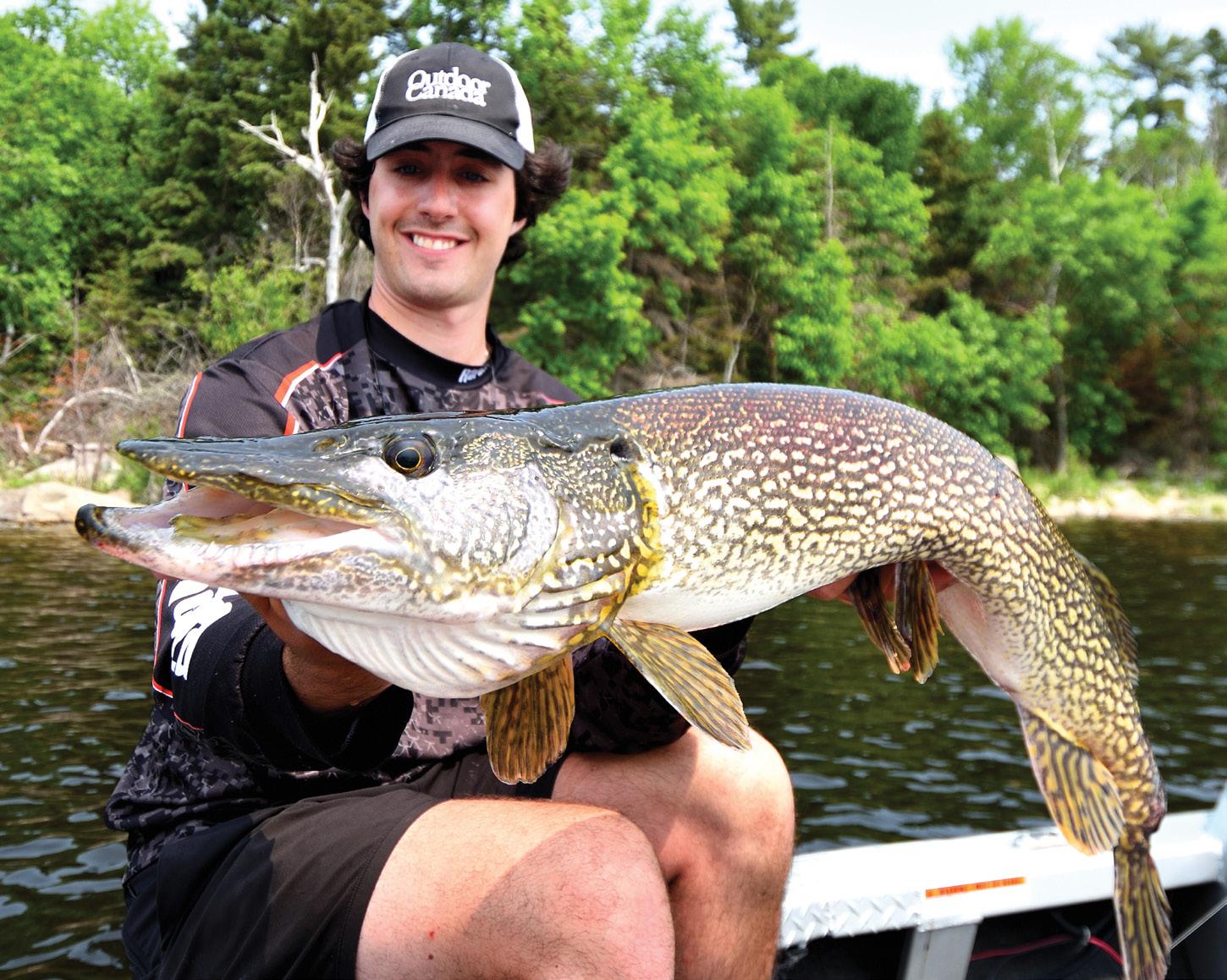
DEPARTMENTS & COLUMNS
VOL. 52, ISSUE 3 22 23 24 25



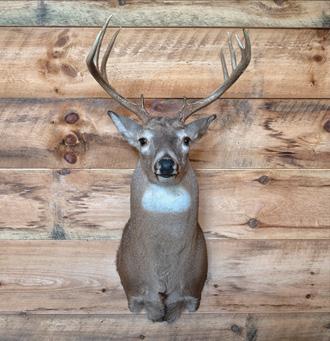
FEATURES
26
BIG FISH MATTER
Planning to keep your next trophy catch? Not so fast. To continue enjoying great fishing, we need to let the lunkers live—and ensure their ongoing survival BY GORD PYZER
36
TOOLS OF THE TRAIL
To guarantee a successful backcountry hunting adventure, you need to pack just the right gear—and now’s the time to start planning BY MARK HOFFMAN
44 RECIPE FOR SUCCESS
When it comes to tackling giant lakers—and enjoying a healthy taste of the Far North—the N.W.T.'s remote Great Bear Lake Lodge offers the full-meal deal BY PATRICK WALSH
52
TOXIC SHOCK
If you thought we’d completely dealt with the threat of poisonous lead in our hunting ammunition, think again BY KEN BAILEY
60
YOUR BEST SHOTS!




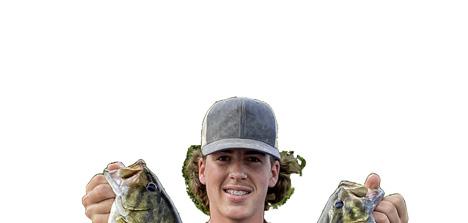






The top images from our annual competition honouring fishing, hunting, family adventure and wildlife and wild places in Canada BY THE EDITORS



COVER LINES 23 Fly-Fishing Challenges 25 Trophy Care 26 Big Fish Blueprint 36 12 Must-Haves for Remote Hunts 44 The Giant Trout of Great Bear Lake 52 Is Your Rifle Ammo Toxic? 60 Prized Photos COVER SHOT HARDCORE YOUNG ANGLER BEN HOOGERS HOISTS JUST TWO OF THE MANY SMALLMOUTH BASS HE CAUGHT AND RELEASED DURING AN ACTION-PACKED AUGUST DAY ON CENTRAL ONTARIO’S BALSAM LAKE. PHOTO BY CHRIS HOCKLEY
OUTLOOK Farewell to a fine friend BY PATRICK WALSH 7 DISPATCHES Our readers write 8 JOURNAL Outdoor inspiration and information BY STAFF & CONTRIBUTORS 20 FAIR GAME The importance of conserving bogs BY ERIKA NAVARRO 22 ON THE WATER Summer’s hottest new bass tactic BY GORD PYZER 23 FLY FISHING Fresh ideas for warm-weather fishing BY SCOTT GARDNER 24 BOWHUNTING Why archery clubs are well worth joining BY KEVIN WILSON 25 IN THE FIELD How to keep your trophies looking like new BY KEN BAILEY 66 HOMAGE Pumpkinseeds BY MIKE FITZGERALD IS YOUR RIFLE AMMO TOXIC? 12 BIG FISH BLUEPRINT WHY LUNKERS ARE IMPORTANT MUSTHAVES FOR REMOTE HUNTS FLY-FISHING CHALLENGES • TROPHY CARE • PRIZED PHOTOS + $8.99
6
WWW.OUTDOORCANADA.CA | 3 OUTDOOR CANADA [ JULY/AUGUST 2024 ] 26 JULY/AUGUST
ONLINE NOW
www.outdoorcanada.ca

Flat-water walleye
Dedicated walleye anglers love the so-called walleye chop, when their favourite lake becomes stirred up just enough to get the bite turned on. But even during calm days when the water is silky smooth, the summer walleye action can still be super hot. The key here is to change up your usual walleye-fishing strategy with these flat-water techniques for fishing deep, as well as for targeting weeds and the shallows. Contributor Mike Hungle (pictured) lays out everything you need to know to get with the program. outdoorcanada.ca/flatwaterwalleye
CONNECT WITH US





Join us on Facebook Facebook.com/OutdoorCanada
Follow us on X @OutdoorCanada @OutdoorCanadaW
Follow us on Instagram @outdoorcanadamagazine
Follow editor-in-chief Patrick Walsh on X and Instagram @OutdoorWalsh
Follow associate editor Scott Gardner on X @OutdoorGardner
FISHING
ZOMBIE MINNOWS
Wait, don’t toss out those dead minnows! After all, they still have an enticing scent and profile. You can give those floaters a second life by fishing or rigging them in these highly effective ways. outdoorcanada.ca/zombieminnows

SUMMER BASS FLIES
Venture into a new world of fly fishing with these patterns for largemouth and smallmouth bass. Each one fills a key bass-fishing niche, from hopping along the surface slop to bouncing across the lake bottom.
outdoorcanada.ca/summerbassflies
ON THE WATER ONLINE
Outdoor Canada fishing editor Gord Pyzer regularly posts expert fishing tips, gear reviews and much more on his blog, “On the water online.” Check in often to stay on top of exciting new developments in the world of angling.
outdoorcanada.ca/blogs
HUNTING
WINGSHOOTING PRIMER
Missing too many birds lately? Summer is the perfect time for a tune up. Let our six-step wingshooting primer get you back in the game with helpful tips on stance, mounting, leading the birds and more. outdoorcanada.ca/wingshootingprimer
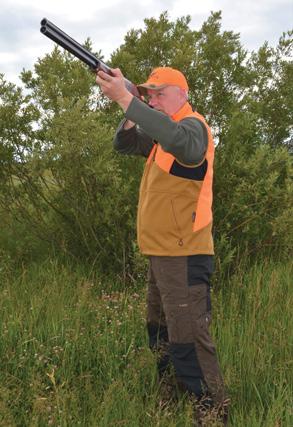
BOWHUNTING FITNESS
Whether you’re putting up and taking down stands, navigating rugged terrain or simply shooting a bow, you need to be physically fit as a bowhunter. Follow these pointers for staying in shape as you prepare for the season ahead.
outdoorcanada.ca/bowhuntingfitness
HUNTING BINOCULARS
Binoculars may be outwardly simple, but the options for hunting are varied and sometimes confusing. If you’re looking to upgrade your binos, here are the main factors to consider, including price, size and optics.
outdoorcanada.ca/huntingbinoculars
4 | OUTDOOR CANADA [ JULY/AUGUST 2024 ] WWW.OUTDOORCANADA.CA

OUTLOOK
BY PATRICK WALSH
Here’s to Tim

IHAD A tougher time than usual putting this issue of the magazine together. It’s not that the articles were particularly difficult to edit, although two of the pieces certainly deserved extra scrutiny before going to press. Any discussion about lead and its potentially harmful effects on wildlife can often be contentious, but hunting editor Ken Bailey did a masterful job of navigating the issue and delivering a thoughtful piece on what hunters should know about lead in rifle ammunition (see page 52). Similarly, debate will likely never end about the merits of preferring photos over skin mounts or full cooking pots when it comes to big fish, but fishing editor Gord Pyzer sure puts forward an excellent case to let ’em go and let ’em grow (see page 26). No, my problem with this issue was my preoccupation with the loss of a close hunting buddy, Tim McEachern.
Every spring, my turkey-hunting season starts with my great friends Rob Pye and his dad, Clarence. We’ve been hunting the opener together on a series of farms over near Orillia, Ontario, for 15 seasons now. Then 10 years ago, a second tradition took hold when Ken Bailey started flying out from Edmonton to join me and our mutual buddy Tim for several days of turkey hunting in Ontario’s Greenock Swamp area.
I first met Tim back in 2005 when he started selling advertising for this magazine, several years before he retired from the ad game and began teaching publishing part-time at a community college. In recent years, though, he dedicated most of his energies to fishing and hunting. He especially loved pursuing spring gobblers. Decked out in ragged old swamp camo, his face smeared with burnt cork, Tim was far removed from his past life as an ad exec, and loving it.
Tim died unexpectedly of a heart attack on May 16, less than two weeks after saying goodbye to Ken and me following our latest five-day turkey hunt together. He was just 68. I don’t know why, really, because we hadn’t done it before, but I took a group selfie before we parted ways. I’m sure glad I did. As it turned out, though, that wasn’t the last time I would see Tim. Stupid me, I forgot my shotgun that day and had to backtrack several hours to fetch it. Tim, being the awesome guy he was, drove my gun out to meet me, saving me a good two hours of driving time.
That was pure Tim. He was generous with everything, starting with his turkey know-how (hence Ken’s nickname for him, the Mentor) and his numerous permissions stretching from Teeswater to his place in Riversdale and beyond. As Ken told me, “I’ll remember Tim for his down-to-earth, goodnatured, positive attitude, his willingness to share, and his passion for the outdoors.”
With that, I dedicate this issue to our great hunting buddy.
Timmy, as I wrote in the tribute section of your funeral home’s website, may you find plenty of fat toms, skein after skein of geese, too many whitetails to count and endless tight lines in the great beyond. I’ll tip one for you later today, old pal. OC














ESTABLISHED 1972



EDITOR-IN-CHIEF & BRAND MANAGER Patrick Walsh
ART DIRECTOR Sandra Cheung
ASSOCIATE EDITOR & WEB EDITOR Scott Gardner
FISHING EDITOR Gord Pyzer
HUNTING EDITOR Ken Bailey
EDITOR-AT-LARGE Bob Sexton
PUBLISHER Mark Yelic
NATIONAL ACCOUNT MANAGERS
Rosemary Bubanovich, Jeff Coyle
RETAIL AND CLASSIFIED ACCOUNT MANAGER
Chris Holmes
MARKETING MANAGER Desiree Miller
DIRECTOR OF RETAIL MARKETING Craig Sweetman
AD TRAFFIC COORDINATOR Michaela Ludwig
DIGITAL COORDINATOR Lauren Novak
CIRCULATION & CUSTOMER SERVICE
Marissa Miller, Lauren Novak
CONTROLLER Anthea Williams
OUTDOOR CANADA IS PUBLISHED BY OUTDOOR GROUP MEDIA LTD.
Outdoor Canada magazine (ISSN 0315-0542) is published six times a year by Outdoor Group Media Ltd.: Fishing Special; May/June; July/August; Hunting Special; November/December; and January/February. Printed in Canada by TC Transcontinental.
SUBSCRIPTION RATES: Canada, one year (six issues), $24.95 plus tax. U.S., one year, $39.95. Foreign, one year, $69.95. Send name, address and cheque or money order to: Outdoor Canada, 802-1166 Alberni St., Vancouver, B.C. V6E 3Z3
MAIL PREFERENCE: Occasionally, we make our subscriber list available to carefully screened companies whose products and services may be of interest to our readers. If you want your name removed, contact us via the subscripton contact below.
Publication Mail Agreement No. 42925023. Send address corrections and return undeliverable Canadian addresses to: Outdoor Canada, 802-1166 Alberni St., Vancouver, B.C. V6E 3Z3
USPS #014-581. U.S. Office of publication, 4600 Witmer Industrial Estates, Unit #4, Niagara Falls, N.Y .14305. U.S. Periodicals Postage paid at Niagara Falls, N.Y. Postmaster: Send address changes to Outdoor Canada, P.O. Box 1054, Niagara Falls, N.Y. 14304-5709. Indexed in Canadian Magazine by Micromedia Ltd.
EDITORIAL SUBMISSIONS: We welcome query letters and e-mails, but assume no responsibility for unsolicited material.
Distributed by Comag Marketing Group. ©2024 Outdoor Canada. All rights reserved. Reproduction of any article, photo or artwork without written permission of the publisher is strictly forbidden. The publisher assumes no responsibility for unsolicited material.
Subscriptions and customer service: 1-800-898-8811
Subscriptions e-mail: service@outdoorcanada.ca
Customer service website: www.outdoorcanada.ca/subscribe
MAILING ADDRESS: Outdoor Canada, 802-1166 Alberni St., Vancouver, B.C. V6E 3Z3
General inquiries: (604) 428-0259
Editorial e-mail: editorial@outdoorcanada.ca
Members of the Manitoba Wildlife Federation, Saskatchewan Wildlife Federation and Alberta Fish & Game Association must contact their respective organizations regarding subscription questions or changes.

JULY/AUGUST 2024 WWW.OUTDOORCANADA.CA 6 | OUTDOOR CANADA [ JULY/AUGUST 2024 ]
A
MCEACHERN
FINAL PHOTOGRAPH: (LEFT TO RIGHT) WALSH,
AND BAILEY
DOUBLE FEATURES
This is just a quick e-mail to say thank you for getting Noah’s fish into the magazine’s “Trophy Wall” (Fishing Special, East edition). He’d been eagerly awaiting, and was pumped to see it come out. We appreciate all you do for not only the magazine, but also for Canadian conservation in general.

BRENNAN & NOAH LOUGH TWEED, ONTARIO
I want to take the time and thank your magazine for the editorial on my wife’s spring black bear in “Trophy Wall” (May/June, East edition). Nicely done. Diane is pretty pleased with it
PLEASE E-MAIL YOUR COMMENTS TO EDITORIAL@OUTDOORCANADA.CA. ALSO CONNECT WITH US ON INSTAGRAM (@OUTDOORCANADAMAGAZINE), X (@OUTDOORCANADA AND @OUTDOORCANADAW) AND FACEBOOK (FACEBOOK.COM/OUTDOORCANADA).
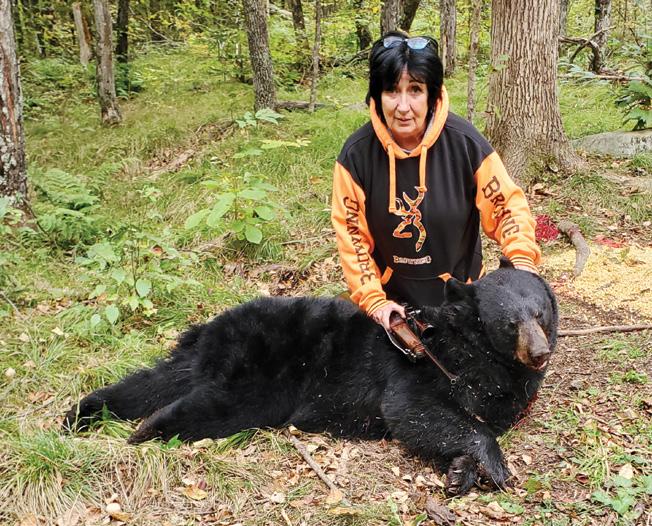
all, and her friends are calling her a celebrity now. Cheers.
DAVE NICHOL SMITHS FALLS, ONTARIO
Editor’s note: Since the “Trophy Wall” section currently only appears in our East edition, here are the photographs again for our West edition readers to also enjoy!
PADDLE PERFECTION
Re. “Homage” to the Sportspal canoe (Fishing Special). I have many memories of family fishing adventures in a classic Sportspal from when I was a kid in the early 1980s. The quality and craftsmanship are exceptional. The durability and functionality are second to none. It’s light enough for one person to carry, and a pleasure to paddle. The adventures continue to this day.
BEN POSTNIKOFF VIA FACEBOOK
GRAND GIFT
That’s lovely! Very generous! Re. “Big donation” (Fishing Special, West edition), about ranchers Edgar and Doreen Thorsen donating 300 hectares to the Saskatchewan Wildlife Federation’s Habitat Trust Fund. OC
DORE LAKE LODGE, SASKATCHEWAN VIA FACEBOOK

MEMORIES WORTH SHARING TWICE
OUR READERS WRITE DISPATCHES OUR READERS WRITE
8
OUTDOOR INFORMATION & INSPIRATION
 BY MARK RAYCROFT
BY MARK RAYCROFT
JOURNAL
SCENE
Belly on up to the brunch buffet! With his antlers still decked out in velvet, a bruiser white-tailed buck surveys a lush soybean field in southern Ontario last August.
8 | OUTDOOR CANADA [ JULY/AUGUST 2024 ]
PHOTO
95th
Anniversary this year of Peterborough, Ontario-based Lucky Strike Bait Works, founded in 1929 by Frank and Elsie Edgar. The first offerings from the family-run business included wooden baits handcrafted from broom handles. Today’s tackle line-up includes spoons, spinners, plugs, soft baits, trolling rigs and numerous accessories.
1,244


Year-to-date wildfires across Canada as of late May, with 99 blazes still active, according to the Canadian Interagency Forest Fire Centre. That’s fewer than last year’s total of 1,544 wildfires for the same time period.
62,000

Documented wild pig sightings in Canada, according to the University of Saskatchewan’s Canadian Wild Pig Research Project. The largest populations of the destructive invasive species are found in Alberta, Saskatchewan and Manitoba.
85th

Anniversary this year of the U.S.-based International Game Fish Association, which aims “to unite anglers worldwide behind a common goal of game fish conservation, driven by cutting-edge research and ethical angling practices.” The association also maintains extensive records of trophy fish.
ON THE RECORD
“Everywhere we looked, we found evidence.”
University of Plymouth marine biologist Richard Johnston recounts when he first discovered tiny fragments of common plastic polymers scattered throughout the environment, leading him to coin the term “microplastics” 20 years ago.Today, microplastics are found in everything from plankton to sportfish to the human body.

NUMBERS GAME
WWW.OUTDOORCANADA.CA | 9
TROPHY WALL
HOT SHOTS
PHOTOGRAPHIC MEMORIES OF FUN DAYS AFIELD AND ON THE WATER
WE ENJOY SEEING pictures of your fishing and hunting accomplishments—and learning the stories behind them. Please e-mail us your images, along with any relevant details (who, what, where and when), and we’ll post them on Instagram and publish our favourites here.

Avid angler and hunter Julia Albers landed this fine brook trout last May while fishing with her mother, Wenda Gibson, at Quebec’s ZEC Pontiac. Julia, who cut her outdoor teeth at the knee of her Grandpa Merv in Deep River, Ontario, was using her favourite lure, a ¼-ounce silver Mooselook.

Max McCracken was eight years old and 50 inches tall last June when he caught this monster pike while kayaking with his brother and mother on Lake Superior’s Batchawana Bay. After quickly taking this photo to judge the length, they live-released the fish with the help of neighbour Dave Butkovich. Says dad Michael: “It has become the talk of the beach.”

Barrett Driedger, 15, was with his dad and grandpa on Alberta’s McLeod River last September when he caught this beauty brook trout. “He’s always been a super-patient fisherman,” says dad Jake Driedger. “It’s so gratifying watching him grow up to be such an avid outdoorsman and conservationist.”
Days before her ninth birthday last August, Charlotte Matchett followed up her personal-best largemouth with this nice walleye on Ontario’s Big Gull Lake.
“She’s an outdoors girl for sure,” says dad Alvin Matchett.
“She loves to fish with me and her brother, especially when she pulls in a better day’s catch.”

10 | OUTDOORCANADA [ JULY/AUGUST 2024 ]
8 PLEASE E-MAIL YOUR PHOTOGRAPHS AND RELEVANT DETAILS TO EDITORIAL@OUTDOORCANADA.CA. ALSO BE SURE TO CHECK OUT OUR INSTAGRAM PAGE: @OUTDOORCANADAMAGAZINE.
JOURNAL



While trolling a black-and-silver Rapala F11 close to shore on Quebec’s Lac McLennan one evening early last July, Alain Chef caught and released this chunky 10.3-pound walleye. He credits photographer and net man Jim Allan with helping him land the “big bruiser.”
Neilburg, Saskatchewan brothers Larry (far left) and Rowdy Flicek recorded some fine catches last summer while fishing with their parents and sister in the north of their province. Larry, 12, tackled this 15-pound northern pike on the Wheeler River, while 13-year-old Rowdy boated this 11-pound laker on Brown Lake.

While vacationing with his family at Laurentian Lodge on northern Ontario’s Mikel Lake last August, seven-year-old Owen Sider won the battle with this 4.75-pound smallmouth bass. “He would be thrilled if his picture was shared,” says mom Marina Sider. “He kept saying no one is going to believe me.” OC
WWW.OUTDOORCANADA.CA | 11


OUTDOOR SMARTS
TOXI C TALK
FOUR ESSENTIAL SAFETY RULES FOR BEGINNER MUSHROOM HUNTERS
BY STEPHAN LUKACIC
WITH THE EVER-INCREASING popularity of mushroom hunting in Canada, there’s a critically important concept beginner foragers need to fully understand: mushrooms are little chemical factories. Some of the compounds they produce are delicious, and some can help us heal. Others can make us extremely ill, however, and some can even kill us, such as those found in the deadly Amanita bisporigera (pictured above). That makes it extremely important to be able to tell the difference between toxic fungi and those that are safe to eat. If you’re new to mushroom hunting, here are four key rules to keep in mind.
EDUCATE YOURSELF Before you even think about bringing any wild mushrooms into your kitchen, learn to identify the common edible species and, more importantly, the toxic species in your area. Carefully study mushroom anatomy, invest in reputable field guides and take classes taught by experienced foragers. For example, I offer weekly in-person instruction on this very subject and more (follow the web link below). Never rely solely on internet sources or apps on your phone for identification.
START SLOWLY Begin your mushroom hunting journey with easily identifiable species that have very few, if any, poisonous lookalikes. Good examples include morels (Morchella spp.), puffballs (Lycoperdon, Calvatia and Bovista spp.) and chicken of the woods (Laetiporus sulphureus and Laetiporus cincinnatus).
VERIFY THOROUGHLY Always cross-reference your initial identification using multiple reliable sources, such as reputable field guides and online resources. If possible, also consult with an experienced forager to confirm your finds. Never consume any wild mushroom unless you’re 100 per cent certain of its identity. There are no maybes in mushroom hunting. If you’re unsure about a mushroom, leave it in the woods. As the wise old saying goes, “There are old mushroom hunters, and there are bold mushroom hunters, but there are no old, bold mushroom hunters!”
RESPECT THE LAND Be mindful of the delicate ecosystems where wild mushrooms flourish. Harvest fungi responsibly by only taking what you intend to use, and leave some behind—especially when harvesting juvenile specimens that have yet to release spores. Fungi differ significantly from plants in the ways they grow and reproduce, so even though overharvesting is rarely an issue, it’s worth keeping in mind that mushrooms are also an important food source for wildlife. Safe hunting! OC

PRICKLY PREDICAMENT
Gun dogs often dive headlong into rough cover during hunts. Sometimes, they come out encrusted in burrs—seed pods or flower heads with teeth or hooks that latch onto their hair. Once entangled, these unwanted hitchhikers can poke, chafe and cut skin, putting the dog out of commission. While burrs are inevitable, learning how to properly deal with them can make sure your dog stays in the game.
PREVENTIVE MEASURES
Long-haired breeds and dogs with a dense undercoat are more likely to get entangled with burrs. Short of shaving the entire dog, the pre-emptive trimming of problem areas such as toes, legs, armpits and the face can help dramatically. Applied in advance, commercial detangling sprays or spray-on cooking oil can also minimize burrs. Some dogs may lick off the oil and nullify its effectiveness, but it’s worth a shot. While most dogs will gnaw burrs off their paws, good dog boots can protect feet from burrs (and other pokey things) in the first place. While hunting, periodically check your dog for burrs to avoid large clumps.
BURR REMOVAL
Burrs vary in size from tiny blueburs to cockleburs, which can be almost an inch long. Depending on the size of the burr and your dog’s hair, you may need to use different removal tactics. Some burrs can simply be plucked out, while others require more effort. For stubborn stickers, apply a detangling oil. This softens the burrs’ hooks so they can be pulled off more easily; use a grooming comb to work the hair around the burrs until they come out. You can also get specialty combs to remove burrs. Mars Coat King Stripping Combs, for example, feature a series of blades to remove knots and burrs. Cutting the hair with scissors, meanwhile, may be the only way to remove burrs on some longhaired dogs. —LOWELL STRAUS
12 | OUTDOOR CANADA [ JULY/AUGUST 2024 ] WWW.OUTDOORCANADA.CA
STEPHAN LUKACIC (FUNGI); LOWELL STRAUSS (DOG)
LEARN TO ID DEADLY FUNGI
INTERESTED IN LEARNING MORE ABOUT MUSHROOMS AND FORAGING FROM STEPHAN LUKACIC? GO TO WWW.OUTDOORCANADA.CA/FUNGI. 8 FOR THE BEST TIMES TO FISH AND HUNT, CONSULT OUR SOLUNAR CHARTS AT WWW. OUTDOORCANADA.CA/TIMES 8 JOURNAL DOG SENSE
BRINGS LEGENDARY LIFELIKE ACTION TO SOFT PLASTICS
A T. MEET THE





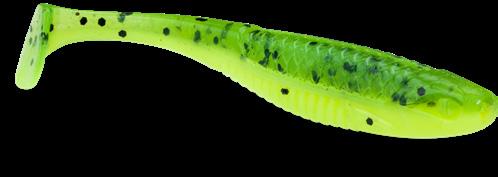





welcome to CrushCit y
angler,
fish are big,
bite
hot.
E
A destination in the mind of every
where
and the
is
It’s what tournament anglers live for and every angler dreams o f . “NEW“ RAPALA
M
rapala.ca AVAILABLE AT: CANADIAN TIRE, BASS PRO SHOPS, CABELA’S, SAIL OUTDOORS, LOTW SPORTS HEADQUARTERS, GAGNON SPORTS, TACKLE DEPOT, LATULIPPE, PRO ADVANTAGE, THE FISHIN HOLE & MANY MORE!
The Mayor TM Freeloader
TM
Bug TM
Bronco
TM Cleanup Craw TM ™ SCAN ME
Ned BLT

BLIND READY
FABARM’S XLR BULRUSH MAX 5 IS IDEAL FOR HUNTING IN TIGHT
SPOTS
BY MARK HOFFMAN
WATERFOWL SHOTGUNS HAVE undergone a well-orchestrated evolution since the days of wooden stocks, blued metal and full-choked barrels. Today, they represent a special breed of shotgun, as tough as the hunters who brave the foulest of conditions to bag a few late-season ducks or geese. And that’s just what Fabarm had in mind when it introduced the XLR Bulrush Max 5.
In the world of waterfowling, you’re unlikely to find this shotgun in every blind. I don’t see that as a reflection of Fabarm’s performance or reliability, but rather the past availability of its offerings. Based in Italy and originally known for its side-by-side shotguns, Fabarm didn’t introduce its first semi-automatic shotgun until the late 1960s; today, the company manufactures 15 right-handed and five left-handed semi-auto hunting models. Raising awareness here of these firearms was no doubt the reasoning behind the Canadian distributor’s request that I test the XLR Bulrush Max 5.
Apply named, it comes decked out in Bulrush camo, the most pronounced aesthetic feature of this well-designed and ruggedly built shotgun. While the exterior is uniquely hunter-driven, it owes its mechanical XLR5 platform to competition guns. At its heart is the revolutionary Pulse Piston system, which acts as a progressive brake that eliminates the need for a valve system. An assumption could be made that this would curtail the use of certain types of ammunition, but to the contrary, the gun can handle everything from target loads to goosebusting magnum loads.
In short, this simple system contains fewer parts, and it’s easy to clean and inevitably more reliable. With light loads, all the pressure is used to reload the gun; with heavy loads, the pressure reloads the gun while activating the Pulse system’s braking. That not only slows the action, it also reduces felt recoil. This reliability and reduction in felt recoil is achieved through what Fabarm refers to as the “fastest cycling semi-auto hunting gun on the planet.” With a cycle speed
of 0.31 seconds for five rounds, it is remarkable indeed.
To enhance downrange performance, Fabarm incorporated its Tribore HP (Hyperbolic Profile) barrel design into the shotgun. Beginning ahead of the forcing cone, the bore gradually tapers toward the choke constriction, reducing recoil and improving pattern performance. Included is a specialized choke, the Exis DK, which is tuned for non-toxic shot in every popular pellet size.
According to Fabarm, this barrel and choke combo allows you to use up to extra-full chokes without any negative effect on the gun, something no other shotgun can do. And to further ensure absolute durability, the guns are tested by the Italian National Proof House to the highest possible rating of 1630 BAR.
As for user-friendly features, the oversized trigger guard, safety, magazine cut-off and extended bolt handle are all designed for enhanced control while wearing gloves in cold weather. Then there’s the competition-bred LR (long rib) that increases the sighting plane by 4½ inches, allowing the
JOURNAL MARK HOFFMAN (SHOOTER, TARGETS); KORTH GROUP LTD. (SHOTGUN); HANS-JÖRG HELLWIG/WIKIMEDIA COMMONS (GOPHER)
FIREARMS REVIEW A QUICK-ON-POINT WATERFOWL GUN 14 | OUTDOOR CANADA [ JULY/AUGUST 2024 ]
shooter to see down the rib with a more comfortable head-up posture. And to reduce glare, the top surface has been masked to provide a camofree black matte finish. Completing the package is a highly visible fibreoptic front sight.
To help protect against rust and corrosion, the barrel extension and bore are chrome-plated, while the bolt is PVD-plated and the chokes are nickel-plated; all of the exterior metal surfaces are covered in camo. Finally, the synthetic stock includes a soft recoil pad and a soft rubber comb. The stock is also coated with a Soft Touch camo process, which provides a rubberized feel for a firm grip in all weather conditions.
TEST RESULTS
When handling the XLR Bulrush Max 5 for the first time, I was surprised at how light it was. My postal scale confirmed that assessment, weighing the gun in at an ounce shy of seven pounds. For a waterfowl shotgun, that weight raises two potential issues: balance and recoil. With a bit of on-point shouldering, however, my concern about balance evaporated. Not only did the gun balance well, it was also quick on point, which is ideal when shooting from a blind or over decoys. Off the bench, the recoil generated by magnum loads indeed reminded me of just how light this gun is. Unfortunately, and not entirely out of character for shotguns, the trigger broke inconsistently and heavier than expected at between six pounds four ounces and seven pounds four ounces. On the upside, the gun comes with a set of stockadjusting shims to tailor the fit to your frame. Another nice touch is the gun’s adaptability for a sling carry (QD sling swivels are included), a decided plus for hunters who slog their way through bog-sucking mud or to a distant blind in the dark.
On the range, I broke my evaluation of the shotgun into three components. First, I patterned eight mixed steel and non-toxic premium waterfowl loads at 40 yards using a full choke. Next, I switched to a modified choke and patterned six mixed steel and non-toxic duck loads of #3, #4, and #5 shot using Birchwood Casey mallard
THE SHOTGUN SPECS IN SEASON


• Gauge: 12
• Total length: 48.5"
• Barrel length: 28"
• Chokes: C, IC, M, IM, F
• Chamber: 3"
• Length of pull: 14.5"
• Drop At comb: 1.5"
• Drop at heel: 2.25"
• Weight: 6 lb 14 oz
splattering targets. Finally, it was off to the trap range where I had my son, Brent, handle the honours for one round. Throughout, the gun cycled both light target and heavy magnum loads with ease
Other than Remington Hyper Sonic Steel, the waterfowl loads patterned low and to the left. As a corrective measure, the comb would have to be raised along with a cast-off adjustment. However, if I were to shoot nothing but the Remington load, I would make no adjustment. When I switched to a modified choke for the six duck loads, the pattern location and density showed some improvement. These results reaffirm why patterning a shotgun with different loads and chokes is essential for ensuring clean kills and a full game bag.
On the trap range, with the gun choked modified, neither it nor Brent disappointed, as he did not miss a single bird. With all the ducks counted, this is a well-made, quick-on-point shotgun that would be right at home in any waterfowl blind. OC
GOPHER GETTIN’
With hunting for big game and birds off-limits until fall, summer is the ideal time to hone your marksmanship skills by heading afield for gophers. Officially, they’re called Richardson’s ground squirrels, but every kid with a .22 knows these little rodents as gophers. And hunting them is more exciting, challenging and downright fun than the uninitiated might expect. You also get to do your landowner friends a favour in the process by clearing their land of these pesky burrowers.
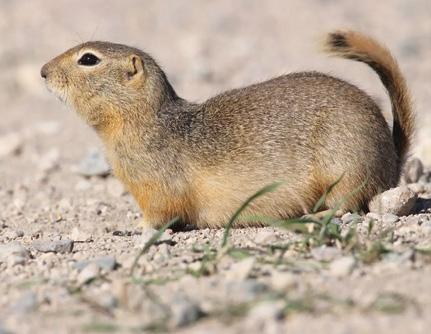
Given the destructive nature of gophers, most landowners welcome hunters—as always, just be sure to get permission before stepping onto private land. Often, you’ll be hunting within range of houses, farm buildings and livestock, so be very safety conscious, especially if you’re with youngsters who can get easily caught up in the excitement. Also be aware of the local regulations. For example, many municipalities on the outskirts of major centres don’t allow the discharge of firearms.
As with all hunting, scouting can pay big dividends—a little windshield time and a pair of binoculars will help identify fields with plentiful gopher numbers. Just be sure to take your time when scanning the countryside, as gophers spend much of their time below ground; watch for their heads popping up from their burrows.
When it comes to gear, all you really need is a pair of binos, a rifle and perhaps a bipod, which is definitely optional. For most gopher hunting, a .22LR is more than powerful enough, and the ammunition is affordable. Those planning to make longer shots often select a .17HMR, though almost any small rimfire is up to the task. A semi-automatic is perfect for shooting multiple gophers in quick succession.
Find yourself a good shooting location, usually on high ground, then wait patiently for gophers to emerge. And if you happen to miss, be ready to quickly shoot again, as a missed gopher will often sit still for a moment before retreating into its hole.
—KEN BAILEY
WWW.OUTDOORCANADA.CA | 15
FOR THE COMPLETE RANGE TEST RESULTS, GO TO WWW.OUTDOORCANADA.CA/FABARMTEST. 8
BR AZI LIAN FISH STEW
WALLEYE AND TROUT STAR IN THIS SOUTH AMERICAN-INSPIRED DISH
RECIPE & PHOTO BY CAMERON TAIT
CULINARY INSPIRATION CAN come in many forms, whether it’s through travel, a particular dining experience or the influence of another person. Whatever the case, I’m always discovering new varieties of cuisine, especially when it comes to global gastronomy. I was introduced to this spectacular dish, for example, by Priscila Spirandelli, a former apprentice of mine from Juiz de Fora, Brazil. Simple, bold and zesty, the recipe is perfectly suited for Canada’s favourite sportfish. Serves 4
1] Dice fillets into one-inch chunks, place in a mixing bowl and add lime juice, salt and pepper. Gently toss to combine.
2] Heat a high-sided saucepan over medium-high heat. Add olive oil, then onions, peppers and garlic. Sauté for five minutes, stirring often.
3] Add paprika and chilies, stir to combine for one minute, then add chicken stock, tomatoes and coconut milk. Bring sauce to a simmer, then add marinated fish, reduce heat to low and stir gently for 20 to 30 minutes.
4] Adjust seasoning if necessary and garnish with chopped cilantro and lime wedges. Serve immediately. OC
FOR THE GLASS
A refreshing and aromatic white wine, Portugal’s Gazela Vinho Verde features tropical fruit notes, along with a slight fizz to enhance the bouquet. Served well-chilled, it makes a great accompaniment to this spicy fish dish.


• 1 medium-sized lake trout fillet
• 4 walleye fillets
• Juice of 1 lime
• 2 tsp kosher salt
• 1 tsp ground black pepper
• 3 tbsp olive oil
• 1 red onion, sliced 1⁄2-inch
• 4 each red and yellow mini sweet peppers, cut in half
• 3 cloves garlic, chopped
• 2 tbsp paprika
• ¼ tsp crushed red chilies
• 1 cup chicken stock
• 796 ml tin plum tomatoes, chopped
• 400 ml tin coconut milk
• Kosher salt and pepper to taste
• 1 tbsp cilantro, chopped
• Lime wedges
TABLE FARE TO WATCH CAMERON TAIT PREPARE HIS VARIOUS DISHES, GO TO WWW.OUTDOORCANADA.CA/FOOD. 8 JOURNAL
WWW.OUTDOORCANADA.CA 16 | OUTDOOR CANADA [ JULY/AUGUST 2024 ]

SLEEP EASY
ALL-NEW TENTS MADE FOR COMFORT—AND WITHSTANDING THE RIGOURS OF THE WILDS
BY THE EDITORS
LONG GONE ARE those uncomfortable nights of sleeping out in the wilds in musty, leaky tents. These days, camping shelters are lighter, brighter, airier and drier than ever, making for a much more enjoyable evening outdoors. There’s also now a huge variety of weather-resistant tents to suit any adventure, whether it’s hiking in the backcountry, car camping or setting up a season-long base camp. Here’s a sampling of what’s out there.
DOME 5 ($2,099.99)
North Face, www.thenorthface.ca
Key features: Geodesic dome design with twolayer fabric; adjustable roof vent; two doors; removable floor; tabs for hanging stoves and gear. The promise: “Built to withstand the harsh-
HORNET OSMO ($399.95 to $549.95) Nemo Equipment, www.nemoequipment.com
Key features: Made of water-repellent rip-stop nylon; one-handed door ties; packed weight of two pounds four ounces; comes in one-, two- and three-person sizes. The promise: “An ultralight shelter with greater volume.”



BASS PRO SHOPS VOYAGER 8-PERSON ($269.99)
Cabela’s/Bass Pro, www.cabelas.ca
Key features: Polyester walls with a polyethylene tarp floor; accommodates three queen-sized airbeds; port for running a power cord into the tent. The promise: “A comfortable campsite home for large families.”
IKOS LIGHTWEIGHT ($569/$695)
Sea to Summit, www.seatosummit.com
Key features: Designed for maximum livable space; polyester floor with mesh walls; wide roof vent; multiple fly configurations; comes in two- and three-person sizes. The promise: “Spacious, versatile comfort-backpacking tent”


VAPOR 2- & 3-PERSON (US$289/US$329) Marmot, www.marmot.com
Key features: Full-fabric ripstop canopy for warmth; top venting to prevent condensation; taped seams; extra guy-out points on the fly; colour-coded clips and poles. The promise: “Protect against strong gusts and wet storms.”
18 | OUTDOOR CANADA [ JULY/AUGUST 2024 ]
THE GOODS JOURNAL

PEAK1 3-PERSON BACKPACKING
($399.99)
Coleman Canada, www.colemancanada.ca
Key features: Taped seams and tub-style floor; star-view roof window; two wide doors and vestibules; reflective guy lines; packed weight of 7½ pounds. The promise: “Great for backpacking, hiking, camping.”


BIG HOUSE 4 & 6
($639.95/$769.95)
Big Agnes, www.bigagnes.com
Key features: Offers standing room; seam-taped polyester fly, floor and walls; multiple interior pockets and accessory loops; comes in four- or sixperson models. The promise: “A cavernous shelter built for the car-camping family.”
REALTREE REGATTA BELL
TENT ($1,263.55 to $2,176.12)
White Duck Outdoors, www.whiteduckoutdoors.ca
Key features: Made with doublestitched, water-repellent, army duck canvas; galvanized steel poles; premium bug mesh; comes in sizes for six, eight and 10 campers. The promise: “Durable, versatile and easy to pitch in 15 minutes.” OC

GIMME SHELTER
To ensure you choose just the right tent for your needs, first consider where and how you plan to use it—and how comfy you want to be.
SIZE Minimal weight and a small packed size is desirable for backpacking or portaging, but less important when vehicle camping. The official “person” rating for tents is based on adults lying shoulder to shoulder across the entire floor, with no space for gear. Unless you prefer such extreme coziness, the practical capacity is typically two-thirds of what’s stated.
SHAPE Tents designed with low ceilings offer more warmth, as well as better stability in high winds. They also pack down small, but their sloped walls mean less liveable interior space. Tents with near-vertical walls, on the other hand, offer enough room to sit or even stand up. Features such as windows, vestibules and multiple doors also add to the comfort level, but they also increase the weight and bulk.
NEW & NOTEWORTHY
BYWAY BACKPACK

Designed to carry a portable vacuum sealer afield, the rugged and lightweight Byway Backpack (US$109) doubles as an all-round pack for anglers and hunters. Features include tie-downs for a fishing rod or rifle, side compartments for tackle or ammo boxes, an insulated top compartment, a main section with a removable divider, and more. PacBak, pacbak.com
CHINOOK FISHING PFD
Updated with input from anglers, the popular Chinook (US$159.95) now has two large clamshell pockets for tackleboxes, an easy-access right-side pocket and a secure tool-holster pocket. It also has six adjustment points for a customized fit, plus a mesh lower-back for ventilation, rod holder, strobe attachment point and reflective accents. NRS, www.nrs.com
BARRIER
SHIRT & PANT


Windproof and waterrepellent, these shirts (US$119.95) and pants (US$139.95) feature an extra-thick weave to prevent insect bites. The shirt has an adjustable collar, roll-up sleeves and three pockets, while the pants have two hip and two leg pockets. Both come in green and grey, as well as men’s and women’s sizes. Jack Wolfskin, www.jack-wolfskin.com
FRESHWATER REVIVALS


With frames made from recycled fishing nets, Vallon’s Freshwater Revivals polarized sunglasses ($187) are designed for sight-fishing, as well as for varying light conditions. Extremely lightweight, they also feature a rubber nose pad and a durable oil- and water-repellent, antiscratch lens coating. They come with a hard case sporting a clip-on hook and belt loops. Vallon, www.vallon.com
MANUFACTURERS
WWW.OUTDOORCANADA.CA | 19
WHY DO WE SOMETIMES SHOW U.S. PRICES? FIND OUT WHY AT WWW.OUTDOORCANADA.CA/COST. 8

FAIR GAME
BY ERIKA NAVARRO
BY GEORGE GRUENEFELD
BY GEORGE GRUENEFELD
Unsung heroes
THE NEED TO RECOGNIZE BOGS FOR THEIR ECOLOGICAL SIGNIFICANCE
BENEATH OUR FEET lies a hidden world, often overlooked but crucial to the health and sustainability of our ecosystem—bogs. These extraordinary wetlands play a vital role in supporting native wildlife, while contributing to global biological diversity. They are also key to flood management and prevention by absorbing runoff and helping stop soil erosion.
As we navigate the challenges facing conservation, it is essential to shine a spotlight on the significance of bogs and their valuable contributions. And there’s no better time than now as we prepare to celebrate World Bog Day, held every year on the fourth Sunday of July.
VALUABLE NATURAL HERITAGE
One prime example showing why bogs are important is the Wainfleet Bog, located in southwestern Ontario’s Township of Wainfleet and neighbouring Port Colborne. Relatively young in geologic terms, this domed bog was formed between 12,000 and 5,000 years ago as the glaciers from the last Ice Age retreated and water collected in the low, flat and poorly drained land behind the nearby Onondaga Escarpment. Over time, this open-water area filled in as plants died, providing habitat for flora and fauna able to withstand the acidic and low-nutrient conditions of the soil.
As a result of more than 200 years of expanding agriculture, peat extraction and transportation activities within and around the bog, however, it has decreased in size and function. Now covering 1,460 hectares, it is nonetheless the largest remaining bog in southwestern Ontario and a sanctuary for myriad species, from elusive amphibians to majestic birds of prey. Its pristine waters and unique vegetation—such as live sphagnum moss, Labrador tea, cotton grass and leatherleaf—provide critical habitat and resources for diverse wildlife, making it a hot spot for ecological richness.
FISH AND GAME HAVEN
At the heart of the Wainfleet Bog lies its role as a haven for fish and game. This ancient peatland offers ideal conditions for spawning and nurturing fish populations, which in turn serve as a vital food source for predatory birds and mammals, sustaining entire ecosystems within and beyond its borders.
With its dense vegetation and abundant insect life, the bog also provides essential habitat for a wide range of species, including waterfowl, wild turkeys and mammals such as rabbits, squirrels, raccoons and coyotes. In fact, the Wainfleet Bog is home to the largest winter concentration of white-tailed deer in the entire Niagara Peninsula watershed. For hunters and outdoor enthusiasts alike, bogs represent invaluable recreational
opportunities and cherished landscapes to explore.
KEY TO CONSERVATION
The ecological significance of bogs also extends beyond their role in supporting wildlife. These wetlands also function as natural filters, purifying water and sequestering carbon, thereby helping to mitigate climate change and enhance water quality. Despite their intrinsic value, however, bogs face various threats such as habitat loss and pollution.
As environmental stewards, it is our responsibility to recognize and appreciate the importance of bogs and advocate for their conservation. Since 1996, the Niagara Peninsula Conservation Authority (NPCA) has dedicated immense efforts to restoring the Wainfleet Bog, for example, and countering the factors degrading this unique ecosystem. (Over the years, the western portion has undergone rehabilitation, while the eastern half has remained untouched, leaving it to the existing species to adapt to changes.)
Making such rehabilitation work possible has been the involvement of partners and stakeholders. These include individual volunteers, nature and conservation clubs, educational institutions, partner municipalities and government agencies, which have provided funding, on-site labour, and assistance with surveys, inventories and monitoring.
Looking forward, the NPCA remains committed to preserving and restoring the Wainfleet Bog, which functions as the heart and lungs of the Niagara Peninsula watershed. Supporting initiatives aimed at conserving and restoring these vital ecosystems can only help but contribute to a brighter environmental future.
So, the next time you have the opportunity to visit a bog, take a moment to reflect on the intricate web of life that surrounds you. In the heart of every bog lies a natural world waiting to be explored and cherished—and conserved for generations to come. OC
ERIKA NAVARRO IS A MARKETING AND COMMUNICATIONS SPECIALIST WITH THE NPCA, WHICH ASSISTED IN PREPARING THIS ARTICLE.
NIAGARA PENINSULA CONSERVATION AUTHORITY FAIR
20 | OUTDOOR CANADA [ JULY/AUGUST 2024 ]
FAIR GAME WWW.OUTDOORCANADA.CA
THE WAINFLEET BOG IS A WILDLIFE HAVEN
LEARN MORE ABOUT THE WAINFLEET BOG AT WWW.OUTDOORCANADA.CA/WAINFLEET 8
ENTRY DEADLINE: JANUARY 2, 2025


THIS CONTEST IS only open to residents of Canada (except Quebec). No purchase is necessary. Professional photographers are not eligible. Photos must have been taken in Canada on or after January 1, 2024. Entries must include details of when and where the pictures were taken. Please enter your high-resolution digital images online at: WWW.OUTDOORCANADA. CA/OCPHOTOCONTEST

FISHING
PHOTOS DEPICTING ANY ASPECT OF SPORTFISHING IN CANADA





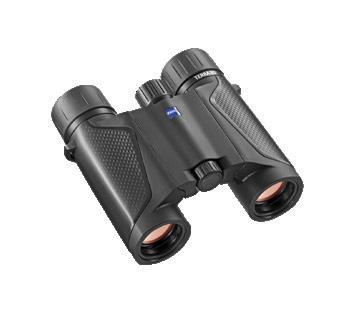
1ST PLACE: 13 Fishing Rod, Reel & Gear Prize Pack (MSRP $500)

2ND PLACE: 13 Fishing Tackle Prize Pack (MSRP $250)
3RD PLACE: 13 Fishing Tackle Prize Pack (MSRP $100)
HUNTING FAMILY


1ST PLACE: Zeiss 3-12x44 Conquest V4 Riflescope (MSRP $1,199.99)
2ND PLACE: Zeiss Terra 10x42 binoculars (MSRP $899.99)
3RD PLACE: Zeiss Terra 10x25 compact binoculars (MSRP $649.99)
PHOTOS DEPICTING YOUNG CANADIANS ENJOYING


1ST PLACE: Fenwick Family Fishing Package (MSRP $1,000)
2ND PLACE: Package
3RD PLACE: Package WWW.FENWICKFISHING.COM


& WILD PLACES

PHOTOS DEPICTING WILDLIFE AND/OR NATURAL LANDSCAPES IN CANADA
1ST PLACE: Nest Pour Over Kit + Java G25 Coffee Grinder Bundle (MSRP $280)
2ND PLACE: Java G45 Coffee Grinder (MSRP $280)
3RD PLACE: Nest Pour Over Coffee Kit + Nest Mug (MSRP $120)







WILDLIFE
FOR THE COMPLETE RULES, PLEASE VISIT WWW.OUTDOORCANADA.CA/OCPHOTOCONTEST
ENTER NOW! WWW.13FISHING.CA WWW.OUTDOORCANADA.CA/OCPHOTOCONTEST
Follow our sponsors on Instagram! @13fishing @zeisshunting @fenwickfishing @vssl PHOTOS
ASPECT
SPORT HUNTING IN CANADA WWW.ZEISS.CA ANNUAL PHOTO CONTEST 14TH
DEPICTING ANY
OF
ON THE WATER
BY GORD PYZER


The jig is up
WHY HOVER RIGGING IS THE SUMMER’S HOTTEST NEW BASS TACTIC
THERE’S ONE THING you can say for certain about bass fishing: if you snooze you lose, especially when it comes to the latest presentations. I mean, no sooner had moping taken centre stage—and almost every top prize in pro bass fishing—when hover rigging pushed it aside. Part of the reason it caught on so quickly was the arrival of forward-facing sonar. Love it or hate it, this technology is now showing us things about fish behaviour we’d never before realized.
For example, we now know how often bass, especially smallmouth, will suspend in one spot, from a few feet off the bottom up to the middle of the water column. Approach the fish in your boat and try to sit over top of them, however, and they’ll drop down to the bottom and go on high alert—if they don’t split up and scatter instead.
That’s what we typically saw when we relied on 2D sonar. Now thanks to forward-facing sonar, we’ve discovered the action can be otherworldly if we stay back from the fish and flick a bait over their heads instead. And that is the secret behind hover rigging.
RIG IT RIGHT
In the days before forward-facing sonar, we’d attach a slender, fluke-style softplastic minnow to an appropriately weighted jig and fan cast it around the boat. If we were lucky, we’d swim it past a bass and get a bite. If we weren’t so charmed, though, we’d sit out the dance. Now that forward-facing sonar lets us know if there’s a party going on 20, 30 or 40 feet away, however, we can crash it from a distance.
The key here is to use a jig that’s much lighter than you’re accustomed to. It should be so light, in fact, that when you pitch it out and let it flutter down, you can shake your rod tip and make the soft-plastic bait tremble like a mortally wounded minnow, just inches above the bass. The presentation can get even better when you fashion your own hover jig set-up.
My favourite way is to use a sharp, unweighted light-wire jig hook with a 90-degree eye. Instead of inserting the hook into the end of the soft-plastic the traditional way, however, I pierce it through the back of the bait, about one-
eighth of an inch behind the nose. I then thread the hook through the body of the soft-plastic so that the shank runs through its top half, exiting where the dorsal fin would be located.
I also use a hook that’s one size smaller than if I were using a standard lead head. That way, the hook eye will be flush with the back and barely emerging once I’ve finished rigging. Finally, I slide a tungsten nail weight into the nose of the softplastic so it runs parallel to, and just under, the shank. I then add a drop of super glue to lock the nail weight in place, preventing an acrobatic bass from flinging it out as it hurls its body out of the water.
Another other cool way to fashion a hover jig is to place your jig hook in a fly-tying vice and wrap the nail weight to the shank of the hook, keeping the weight’s pointed end below and just in front of the hook eye. That way, the pointed end can act like a bait keeper. And as a bonus, your custom hover jig will cost just pennies compared to a store-bought variety (pictured).
KEEP IT LIGHT
No matter how you fashion your hover rig, keep it as light as possible. That way, when you cast it out—I prefer to pitch it underhanded—you can make it perform a death-defying dance over the fish. You’ve never been able to do that before with a jig-hooked soft-plastic, and when the bass see it, they’ll go crazy. The same goes for walleye, for that matter, definitely making hover rigging the hot new tactic of the summer. OC
FISHING EDITOR GORD PYZER MAKES THE CASE FOR BIG FISH ON PAGE 26.
TACKLE TIPS
Since hover rigging is a finesse presentation, I favour using a seven-foot to seven-foot six-inch medium- to mediumlight-action spinning rod and reel spooled with six- to eight-pound braid. Using an Alberto knot, I also attach a monofilament or fluorocarbon leader of similar strength. And because the rig features a needle-sharp hook, there’s no need to slam the fish. Simply lean into it instead, and the hook will embed itself.
GORD PYZER (ANGLER);
CORE TACKLE (HOVER JIG); PATRICK WALSH
22 | OUTDOOR CANADA [ JULY/AUGUST 2024 ]
(BASS AND FLY ROD)
BASS CAN’T RESIST A HOVER JIG (INSET)
FLY FISHING
FLY FISHING
BY SCOTT GARDNER
BY SCOTT GARDNER

Summer sport
TOO HOT FOR TROUT FISHING? TAKE ON A NEW CHALLENGE INSTEAD
FOR MANY ANGLERS across Canada, summer is peak fishing season. However, it’s often a different story for fly anglers, especially those who mostly fish for trout in rivers. In many regions, low summer flows and higher water temperatures make trout fishing unproductive and, at times, ethically questionable. So, what’s the ardent fly angler to do between Canada Day and Labour Day? For me, summer is a low-risk time to experiment with different fish species, places and techniques. If my other options are to ride the couch or accidentally kill heat-stressed trout, I’d rather get some fresh air and take a chance on the unfamiliar. Surprisingly often, I end up discovering enjoyable new aspects of fly fishing in the process. And even when things don’t pan out, I learn a lot from the failures. To help fire up your fly-fishing imagination, here are some ideas for fun summer challenges.
ONE FLY
It’s a well-known psychological phenomena that working within constraints inspires people to come up with creative solutions. The ultimate fly-fishing version of this is spending a day on the water with just a single pattern. (Or if that’s too extreme, only surface patterns.) This idea has been around for a while, and I used to think it was pretty silly—until the day I hit the water with just a box of Muddler Minnows in sizes 10 to 4. For starters, I wasted zero time stressing about patterns. It also forced me to think tactically and focus only on high-percentage spots. Most of all, once you catch a few fish, it’s a vivid reminder that where and how you present a fly is very often more important than the pattern itself.
HEAD DOWN
Ever wonder what’s downstream of your beloved trout water? When rivers widen and slow down, there’s often some pretty great action for other fish species. In my part of the world, the lower reaches of many trout rivers are swarming with smallmouth bass, and sometimes walleye, white bass, drum and even muskies. River smallmouth, in particular, are incredibly fun to catch on the fly rod and, in many places, rarely targeted by anyone, let alone fly anglers. This is also the perfect opportunity to wet wade in just your boots or even a pair of old sneakers,
which is another one of summer’s great pleasures.
STAY CLOSE
In our water-blessed nation, many of us regularly pass by creeks and ponds close to home while dreaming of more exotic fishing destinations. But it’s a safe bet you’ll find fish in at least some of those waters, most likely flyfriendly species such as bass, sunfish, perch and who knows what. Long summer nights are the perfect time to spend a few hours exploring such spots. You just might discover an overlooked—and underfished—gem.
GET DEEP
Fishing stillwater during summer is the perfect opportunity to finally try the most underused tool in Canadian fly fishing—sinking line. In rivers, the current helps sink flies, but on lakes, even weighted patterns only get down a couple of feet. Unless you’ve got the patience to let your fly sink for about five minutes after every cast, you need different gear. If you’re reluctant to buy an entirely new line, you can opt for a sinking leader, such as Rio Products’ VersiLeader or an Airflo Polyleader, for about $15. These loop on to a floating line, turning it into a decent approximation of a sinking one. Sinking gear is awkward to cast at first, but hang in there. Quicky getting your fly down four, six or eight feet opens up a new world.
STAY FLY
When fishing with friends who only use conventional gear, it can seem natural, even polite, to leave your fly rod at home. That’s especially the case in boats, where fly anglers may need extra room or special positioning. But if your companions are cool with it, stick with the fly rod. You probably won’t catch as many fish as them, but you never know. Any gamefish that will hit a lure, will hit a fly. If you’re casting or trolling in shallow or mid-depth water, and you’ve got the right tools (such as that sinking line), you’re in the game. And if you happen upon a mayfly hatch, the spin guys will be begging you for flies. OC
ASSOCIATE EDITOR SCOTT GARDNER EMBRACES SUMMER’S CHALLENGES.
FLY WWW.OUTDOORCANADA.CA | 23
DIFFERENT
TRY TARGETING A
SPECIES
BOWHUNTING
BY KEVIN WILSON

Group benefits
WHEN IT COMES TO ARCHERY CLUBS, MEMBERSHIP HAS ITS PRIVILEGES
MY WIFE AND I just returned from the annual banquet of the Alberta Bowhunters Association. Aside from breaking bread with amazing people who share our passion for archery and bowhunting, we thoroughly enjoyed networking, exchanging countless stories, and recognizing members for their achievements through the organization’s awards program.
Following the banquet, many of us continued to visit into the wee hours of the night. Reuniting with long-standing members, and getting to know newcomers reminded me of just how special it is to be an active participant in one of the best communities in the world of hunting. Sharing information, strategies, successes and failures—as well as making new connections—is truly a special thing.
Carrying this communal exchange over to the local level, I highly recommend bowhunters get a membership at their local club. For similar reasons, I enjoy being a part of my own club, the Parkland Bowbenders. Thanks to a great executive, our membership is growing every year, and with more members come more opportunities to shoot with different people, both recreationally and competitively. And as a bonus, these new relationships invariably lead to exciting new hunting opportunities. Networking aside, there are several other benefits to joining local archery clubs.
COMPETITIONS
At the local level, most clubs feature one or more ranges with static target butts, as well as 3D targets. With plenty of different 3D animal targets strategically placed in realistic hunting scenarios, shooters can experience field-like conditions at variable distances.
If you’ve never tried shooting 3D before, it’s like working your way through what’s best described as a golf course for bowhunters. Instead of hitting a ball down the fairway, however, you work your way through the woods launching arrows at animal targets. These ranges are typically restricted to members only, and available for practice rounds when tournaments are not underway.
Then there are special 3D tournaments, either closed club competitions or sanctioned 3D tournaments hosted by individual clubs. Growing in popularity, these events offer something for every archer, from youth to seniors, using everything from compound to traditional bows.
EDUCATION & MENTORING
As far as learning and mentoring goes, local clubs are tough to beat. As with
many other archery clubs, my local club hosts seminars and coaching sessions for young archers, as well as other special events from time to time. If you’re new to archery and bowhunting, there’s no better place to meet experienced shooters and bowhunters, and develop your archery skills. If there’s one thing I’ve gleaned from almost four decades of shooting at local clubs, it’s they are full of friendly folks willing to mentor newcomers.
AWARDS PROGRAMS
Undeniably, one of the most appreciated elements of a club membership is the awards program. The Alberta Bowhunters Association offers an amazing example. It recognizes individuals for specific achievements and contributions within the archery and bowhunting community, as well as category awards for all members achieving benchmarks in their bowhunting journey. For example, members can work toward a Small Game Award, Bowhunter Award or Master Bowhunter Award by fulfilling specific eligibility requirements. The pinnacle achievement is the association’s Grandmaster Award, which is earned by taking six Pope and Young class big-game animals. This, and the other club award programs, serve to enhance awareness, celebrate achievement and foster community involvement.
CONSERVATION PROJECTS
Whether at the local or provincial level, clubs also often administer a wide variety of community and conservation projects. Examples include the National Archery in the Schools Program, educational and public awareness initiatives, provincial wildlife habitat enhancement projects, and other community-based outreach programs promoting the benefits of archery and bowhunting.
In the end, clubs and associations serve to improve involvement in bowhunting, while providing a credible base to lobby for improved bowhunting opportunities across the country. And perhaps above all, they promote conservation and ethical hunting practices, honouring the animals we value and hunt. OC
ALBERTA’S KEVIN WILSON IS A LONG TIME ARCHERY CLUB PROPONENT.
24 | OUTDOOR CANADA [ JULY/AUGUST 2024 ] KEVIN WILSON (3D TARGET); SHUTTERSTOCK (DEER MOUNT)
3D SHOOTS ARE A CLUB BENEFIT
IN THE FIELD
BY KEN BAILEY

Trophy care
PROTECT YOUR INVESTMENT IN TAXIDERMY WITH SIMPLE MAINTENANCE
AS HUNTERS, WE look to taxidermy to honour the game we’ve taken and to forever remind us of time spent afield with family and friends. Ensuring our wildlife home decor lasts a lifetime, however, does require some maintenance. I recently had the chance to visit Darren Shipp, the owner of Lorette, Manitoba’s Wild North Taxidermy, to learn what’s required to keep our precious trophies looking as good as the day we brought them home.
According to Darren, the long-term care of any trophy begins when deciding where to display it. We’ve all seen deer mounts that look ancient and faded, even though they’re not that old. Darren suggests that’s because they’ve been exposed to the sun’s damaging UV rays. With that in mind, avoid placing mounts or rugs where they’ll be in direct sunlight.
You should also avoid placing trophies where they’ll be exposed to extreme heat. While a deer, elk or moose mount above a fireplace may offer a classic look, for example, regular use of the fireplace can result in cracking, especially around the trophy’s nose and lips.
As for cleaning and preserving your trophies, the process varies depending on whether it’s a shoulder or full-body mount, rug, bird or skull mount.
SHOULDER & FULL-BODY MOUNTS
Darren recommends cleaning shoulder and full-body mounts every three or four months with a damp cloth, wiping with the grain of the hair. Otherwise, dust can accumulate and destroy your trophies over time by attracting moisture and eventually becoming sticky.
To ensure the eyes retain their lustre, meanwhile, gently rub them with a cotton swab and a little glass cleaner; they’ll instantly regain their lifelike sparkle. And to give the nose pads a realistic wet-looking appearance, Darren recommends applying a light coating of non-yellowing clear gloss.
Excessive or inadvertent handling of a mount can cause indentations in the hair. To easily remedy this, rub and roll the hair down with the grain, then comb it with a wire brush (a dog brush is ideal). Again, ensure you only brush the hair with the grain.
As for antlers and horns, which can become dull-looking over time, Darren recommends restoring their lustre by wiping them down with a cotton cloth and a mixture of 40 per cent boiled linseed oil and 60 per cent turpentine. While this technique is effective for all antlered game, he says it really brings out the best in moose and elk antlers. He cautions against using a lacquer, however, saying you want to clean, not coat, the antlers.
RUGS
A rug made from a bear, wolf or other game is easy to maintain, Darren says. For starters, avoid walking on it, as that risks introducing dirt and other contaminants. It also breaks the individual hairs. If the rug does become dirty, Darren recommends wiping down the face with a damp cloth before vacuuming the hide. He also suggests putting a couple of fingers over the vacuum’s nozzle to lessen the suction and reduce the likelihood of damaging hairs. Once you’ve finished vacuuming, brush the hair back into position, again ensuring you work with the grain.
As for treating and cleaning the eyes, meanwhile, Darren says to follow the same procedure you’d use for shoulder and full-body mounts; similarly, clear gloss will revitalize the nose.
BIRDS
It’s easy to keep bird mounts looking fresh and clean. They require little more than a gentle wipe with a soft, damp cloth, always in the natural direction of the feathers. Again, a cotton swab and some glass cleaner will bring the sparkle back to the eyes.
SKULLS/EUROPEAN MOUNTS
For the antlers, again use the turpentine and linseed oil mixture for long-lasting vitality. As for protecting the skull, Darren recommends sealing it with a non-yellowing clear coat (if the taxidermist didn’t already do it). That way, future maintenance will be as simple as a periodic wipe down with a damp cloth. OC
HUNTING EDITOR KEN BAILEY KEEPS HIS TROPHIES LOOKING LIKE NEW.
OTHER RISKS
We’re fortunate our climate doesn’t allow for the same damage trophies can endure in places with warmer, more humid environments. If a hide is properly tanned, for example, insect damage is seldom a problem here, Darren says. Of course, unexpected risks are difficult to protect against. As we spoke, he was repairing a black bear mount that had been seriously damaged by squirrels—I guess the long, silky hairs make for great nest-lining material!
WWW.OUTDOORCANADA.CA | 25
REMOVE DUST FROM SHOULDER MOUNTS

Forty-inch-plus pike are among the rock stars of the
26 | OUTDOOR CANADA [ JULY/AUGUST 2024 ] GORD PYZER
fishing world
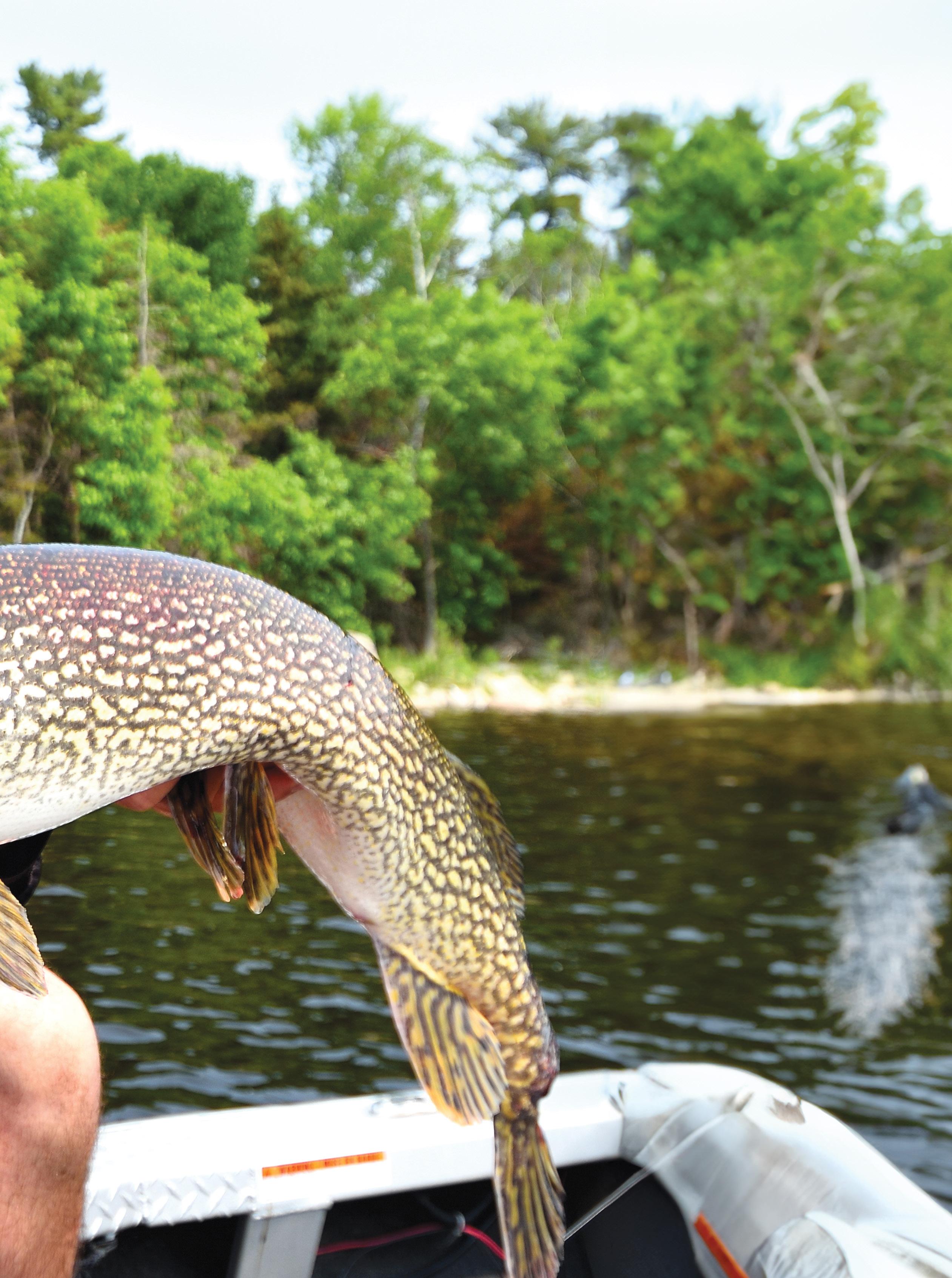 BY GORD PYZER
BY GORD PYZER
BIG FISH MATTER
Planning to keep your next trophy catch? Not so fast. To continue enjoying great fishing, we need to let the lunkers live—and ensure their ongoing survival
WWW.OUTDOORCANADA.CA | 27
»
What do big 30inch walleye, 40-inch pike and 50-inch muskies have in common? They’re all rock stars of the fishing world. The same goes for 20-pound-plus lakers and four-pound-plus smallmouth bass and brook trout. These magnificent fish also share something else in common—they’re all big, old, fat, fertile, female fish, or BOFFFFs as they’re better known in the scientific community. Without them, we wouldn’t have the exceptional fishing and extraordinary fisheries we enjoy across Canada.
Of course, the opposite is also true. Just look closely at most of the country’s stressed fisheries and it quickly becomes clear they lack these bigger, older mature fish. BOFFFFs are so important that Bruce Tufts, who supervises the prestigious Freshwater Fisheries Conservation Lab at Queen’s University, had T-shirts made for his students with the slogan “Big Fish Matter” emblazoned on the sleeves. So, why exactly do big fish matter? From a sportfishing perspective, they certainly matter because, well, most anglers simply want to catch trophy fish. But from a biological standpoint, big fish matter for far more important reasons. And it’s those very reasons anglers need to understand and embrace in order to ensure the ongoing health of our fisheries.
REPRODUCTION
The first key reason big fish matter centres on the quantity and quality of their eggs. Bruce Tufts points to walleye as an example, noting how a 12-pound female produces far more eggs than three four-pound females combined.
Not only do these big fish produce more eggs, he adds, but the eggs are also supremely bigger and much more vibrant, with greater fat content and higher nutritional quality. This ensures the larvae that hatch have a much better chance of survival, especially during the first winter starvation period under the ice—one of the most perilous stages of life for a wild fish in Canada. They’ll also have a much better chance of being recruited into the population and producing strong year classes.
“What it means is that as big female fish get older, their contribution of quality eggs is exponential in the population,” Tufts says.
“And so those big fish are really important. The paradox is that we have traditionally removed them from the population.”
Their own reproduction aside, BOFFFFs also show smaller, younger walleye the ropes when it comes time for them to spawn for the very first time. Namely, they’ll follow the more experienced adults to the best windswept cobble shorelines, shoals and currentexposed areas, learning where to lay their eggs.
“Walleye tend to congregate in schools at different times of the year, and spawning is one of those physiological requirements the fish have to go through,” says biologist Dominic Baccante, who worked in the Ontario government’s Walleye Research Unit. “For young walleye just coming into maturity, they start to get the pheromones and cues that tell them that they should be looking for spawning grounds. So, they follow the older mature fish.”
Biologist Bruce Tufts says anglers must recognize the importance of conserving big fish

28 | OUTDOOR CANADA [ JULY/AUGUST 2024 ]
TUFTS (TUFTS); GORD PYZER (WALLEYE)
BRUCE

NUTRITION
Asimilar situation occurs as smaller fish mature and begin to seek out a heftier diet. “The behavioral side of things is very important,” says Baccante. “That’s why we’ve always promoted the idea of maintaining a balanced fish population in terms of age groups. Those older walleye have a lot of learned behaviour in regards of where feeding and spawning grounds are located.”
WWW.OUTDOORCANADA.CA | 29 »
Mature walleye point the way to spawning and feeding locations
We often forget that younger eight-, 10- and 12-inch fish such as walleye, bass, trout, pike and muskies are prone to predation and therefore go about their early life in ways quite different from the BOFFFFs that optimize their daily routines. The smaller, less mature fish typically hide in the weeds and around cover, venturing out into more open-water areas only when they’ve grown bigger and older.
Amazingly, that’s why our favourite spots for big walleye, bass, lake trout, northern pike and muskies tend to hold only big fish, observes Tufts. I can certainly attest to that. On my home waters of Lake of the Woods, I’ve accumulated a handful of muskie locations where I’ve only caught big fish over the course of 47 years of intense fishing.
“If a big fish is removed from a spot, and you catch another fish off that spot, even a year or two later, it’s often also a big fish,” says Tufts. In particular, he says research has shown big fish will occupy the best spawning areas, as well as the prime spots offering the most food and energy reserves. “If you remove a fish, even experimentally, another big fish will take its place. It’s something that evolution has fine-tuned over millions of years.”
Baccante agrees, noting how big, old, fat, fertile, female walleye will vacate spring spawning areas much earlier than smaller, younger walleye, and much sooner than many anglers realize. They’ll retreat to deeper, cooler, main-lake structures—underwater points, deep rock piles and shoals—where they can optimize their growth, control their metabolic rate and produce more eggs by marauding on schools of super-nutritious pelagic ciscoes.
In explaining the unique behaviour of big walleye, he refers to fellow biologist Peter Colby, his former colleague at the Walleye Research Unit. Colby wrote Synopsis of Biological Data on the Walleye for the UN’s Food and Agriculture Organization, looking at the growth traits of walleye in lakes with and without ciscoes. He found that
once the predators finally reach an appropriate size, they start feeding on the outrageously nutritious silvery prey, and their growth rate skyrockets off the charts.
“It’s based on energetic behaviour and rules,” says Baccante. “They take advantage of the more nutritious food, because they’re not going to get a lot of nutrition
from the shallow littoral [shoreline] zone yet.” Instead, he says, the larger ciscoes out in deeper water are much more beneficial to the larger females. “Walleye will go towards where these prey fish are schooling. It outlines the importance of maintaining a balanced population with these older mature fish.”

PREDATION
Iwas in awe listening to Tufts and Baccante explain how smaller, younger fish acquire behavioural knowledge from BOFFFFs. It implies that if we remove the big fish from the population, we not only eliminate the highest quality reproductive potential, but also years of accumulated growth and critical fishy acumen.
As a case in point, Tufts points to a poorly run bass tournament in 2019 that resulted in 195 dead fish.
When a fishery loses its big fish, the prey species can take over
After he and his team from Queen’s helped conservation officers investigate the incident, they aged the dead fish at their lab. The findings were disturbing. “We determined that the population had lost 1,700 years of growth.”
While he points out such incidents are rare, Tufts stresses the need for ensuring big fish are properly live-released. “I’ve spent a lot of time as a fish physiologist, trying to educate anglers on the
30 OUTDOOR CANADA WINTER 2012 WWW.OUTDOORCANADA.CA 30 | OUTDOOR CANADA [ JULY/AUGUST 2024 ]

COD CONUNDRUM
THE COD FISHERY on the Grand Banks of Newfoundland and Labrador was once one of the greatest living biomasses the world has ever seen. The schools were so thick, early seafarers had difficulty scooping up water because their buckets became so full of big fish. As we know, the East Coast cod population collapsed in the late 1900s after centuries of relentless commercial overfishing, and it has not bounced back. And as fisheries biologist Bruce Tufts observes, the cod population now lacks critically important big, old, fat, fertile, female fish, and without them, it will be difficult to recover.
value of those fish to the population, trying to get them to be extra vigilant,” he says. “Big fish are not just a commodity in a tournament. We’re lucky to use them and we need to look after them.”
The loss of accumulated growth aside, removing or greatly reducing the number of BOFFFFs in a fishery can also flip the table on the predator-prey relationship. In the absence of big fish, the prey they previously consumed can thrive and take over instead. And once that happens, Tufts says, it can be difficult for walleye, bass, trout, northern pike and muskellunge to regain control. The fish can even reverse roles, with the predators becoming prey in their earlier life stages—think hordes of smelt gobbling up precious young-of-theyear lake trout and whitefish.
Baccante recounts once dis-
FOR GORD PYZER’S “DOC TALKS FISHING” PODCAST ON BIG FISH WITH BRUCE TUFTS, GO TO LINKTR.EE/DOCTALKSFISHINGPODCAST.
cussing this same problem with the fisheries folks in Minnesota. They were desperately trying to restore the walleye population in a lake where the big fish had been overharvested, and the sucker population had since ballooned. “Some people blamed the suckers, but that wasn’t what made that fish community go out of whack,” he says. “The suckers dominated because their predator was gone.”
And again, restoring the balance in such a situation can be difficult. “Just removing the suckers, if you don’t have the conditions for the walleye to come back, doesn’t matter,” Baccante says. “Anyway, they weren’t very successful because suckers are very prolific, and when you start to remove them, they respond to exploitation and just produce more eggs.”








WWW.OUTDOORCANADA.CA | 31 GORD PYZER (LAKE TROUT); SHUTTERSTOCK (COD) ® /williamslures www.williams.ca Also available and 6 more...
»
8
WHITEFISH®







RESTORATION
To also ensure healthy populations of big fish, Tufts warns that maintaining natural fish habitat is overriding and non-negotiable. On many of the best salmon and trout rivers, for example, we have traded off the choicest rapids and riffles for hydro dams, and accepted hatcheries as a mitigation strategy. This approach has failed miserably.
“It speaks to some really serious issues we’re trying to grapple with these days, because we’re talking about species that are important to anglers,” Tufts says, pointing to the program to restore Lake Ontario’s extirpated Atlantic salmon population. “The challenges are incredible. Part of it is producing fish artificially in a hatchery, then releasing them and expecting them to know how to survive, what to eat, and how to
flee predators—things that are learned behaviours.”
Rob Swainson, a retired brook trout biologist with the Ontario government, chuckles when I mention Tufts’ comments about protecting critical fish habitat. He recounts the time he walked into the Ontario Power Generation office at the Alexander Falls Dam on the Nipigon River, home of the world-record brook trout. It was 1988, and he naively told the workers he was going to put them out of business. “They laughed at me.”
The situation was dire, however, and the threat of imposing the Fisheries Act caught their attention. “When I stood on shore, I could see the drawdown was over three feet from where the trout had spawned in the fall,” Swainson recalls these many years later. “The eggs were high and dry.” The world-

ON THE WATERFRONT
DEGRADED SPAWNING GROUNDS are in desperate need of stewardship in order to get the most from big, old, fat, fertile, female fish, says Robert Pye, executive director of Watersheds Canada. “With the pressures from increased development, invading species and climate change, there’s never been a more critical time for lake stewardship education,” he says. “Waterfront property owners are the first line of defence for fish habitat, especially when they understand their naturalized shoreline can protect local spawning grounds from erosion and runoff.” Clearing spawning beds, revitalizing nursery areas and planting trees along cold-water streams, for example, can significantly support fish-management goals.

32 OUTDOOR CANADA WINTER 2012 WWW.OUTDOORCANADA.CA 32 OUTDOOR CANADA WINTER 2012 ROB SWAINSON (SWAINSON); BOB SEXTON (WATERFRONT) 32 | OUTDOOR CANADA [ JULY/AUGUST 2024 ]
® /williamslures www.williams.ca
Also available and 12 more...

class brook trout fishery, which was on its deathbed, was rejuvenated not a moment too soon.
These days, the river is being managed under a strict water-flow agreement that puts trout at the top of the priority list. Swainson now goes out of his way to compliment OPG for recognizing the problem, then training staff and working tirelessly to address it.
Incredibly, the fact the Nipigon’s
last few big old female brook trout were saved highlights another biological principle now coming to the forefront. According to Swainson, BOFFFFs have what is known as a “storage effect,” which allows them to maximize their energy reserves, survive tough environmental conditions and eventually spawn, producing an incredible number of high-quality eggs—if conditions finally improve.
»
WWW.OUTDOORCANADA.CA | 33
Rob Swainson’s work with Nipigon brookies showed big fish can be resilient





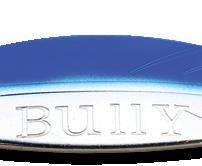



REGULATION
Of course, never getting to the stage where life-and-death surgery is required is always the best course of action, which is why it’s so important to put BOFFFFs on a pedestal and protect them through special regulations, such as slot limits and mandatory catch-and-release. Getting to that point on the Nipigon has certainly contributed to the revival of the brook trout population, for example, but it wasn’t easy at first.
“It’s hard to believe, but at the time, many people did not believe you could catch and successfully release a brook trout,” Swainson says of his early work on the northern Ontario watershed. “You can’t let these fish go, they’re too fragile. That is what they believed.” So to convince them otherwise, he put fish-tagging guns in the hands of local anglers, with each tag bearing a unique individual number and a simple message: Please release me.
“It was endless, the information we got,” Swainson says. “Anglers could see how often the fish were being caught, how small the population really was and how far the trout moved.” They also got an idea of how many fish were being retained by anglers. For example, of the just 30 brook trout tagged over two years in all of Lake Nipigon—Ontario’s largest inland lake—11 were caught again and killed. And that number may have been even higher due to non-reporting. Says Swainson: “It was mind-blowing.”
But the deal-sealer in terms of
convincing anglers that catchand-release works, he says, came when the tagging program revealed between 15 and 35 per cent of the large brook trout were caught at least twice, by the very same anglers who had originally tagged them.
On Jessie Lake, a closed system between two dams on the Nipigon River, 10 per cent of the tagged fish were caught an astonishing three times by the same anglers who had tagged them.
With such shocking statistics staring everyone in the face, it was no surprise special brook trout regulations designed to protect the big fish were quickly put into place. Just as anticipated, the BOFFFFs, with their remarkable “storage effect,” have since brought the fishery back to its previous glory. Still, Swainson worries about anglers with short memories forgetting their history lessons.
“With today’s angling pressure on the system,” he frets, “the fishery will quickly collapse if the regulations are ever relaxed.” His observation serves as both a warning and a ringing endorsement for protecting big, old, fat, fertile, female fish. If we give them good homes and protect them when they’re vulnerable, these rock stars of the fishing world will provide us with world-class angling forever. Fail to do so, however, and we ignore them at our peril. OC
FISHING EDITOR GORD PYZER HAS LONG BEEN A VOCAL ADVOCATE OF PROPERLY LIVE-RELEASING BIG FISH TO SWIM ANOTHER DAY.

34 OUTDOOR CANADA WINTER 2012 WWW.OUTDOORCANADA.CA 34 OUTDOOR CANADA WINTER 2012 JOHN CLEVELAND 34 | OUTDOOR CANADA [ JULY/AUGUST 2024 ]
Measures such as mandatory catchand-release help conserve big fish ® /williamslures www.williams.ca BULLY® CANADA Also available and 10 more...






Canada’s backyard is waiting. Sponsored by the Canadian National Sportfishing Foundation With over 1 million lakes, rivers and streams to choose from, you don’t have to travel very far to cast a line. June 29 - July 7, 2024 catchfishing.com @CatchFishing @KeepCanadaFishing

Tools of the trail
To guarantee a successful backcountry hunting adventure, you need to pack just the right gear—and now’s the time to start planning
BY MARK HOFFMAN
36 | OUTDOOR CANADA [ JULY/AUGUST 2024 ]

So much for the days when we could count on a successful hunt out in the back forty. Thanks to improved access and with it, more hunting pressure, we now often need to leave the beaten track far in the rear-view mirror if we want to ensure we don’t return home empty-handed. That’s particularly the case when it comes to hunting big game such as goats, sheep, caribou and mule deer in the high country. And, of course, heading far afield means you also need to carefully select just the right gear to bring along.
I shudder when I look at my first backcountry hunts, equipped as I was with ill-fitting backpacks, leaky tents, heavy rifles, terrible food, soggy clothing and leaky boots. And let’s not even talk about the lack of proper emergency gear. In retrospect, I’m grateful for the success I had on those early hunts, although I have to concede I’m not sure how I managed to pull them off.
These days, thankfully, backcountry adventurers have access to some of the most specialized camping and hunting equipment the marketplace has ever seen. To get you started on your packing list for the coming season, here’s the lowdown on what you need to ensure an enjoyable, safe and successful foray beyond the back forty.
» WWW.OUTDOORCANADA.CA | 37 BROCK VANDOR

1. RIFLE
WHEN SELECTING A backcountry rifle, weight, accuracy, reliability, toughness and calibre should all factor into your decision. While various rifles may have mountain or backcountry in their names, they’re not all created equal. The rifle itself should weigh no more than six pounds. By the time you add a scope and mounts, however, the combined weight may tip the scale at 7½ pounds, which approaches the upper limit for an all-day-carry backcountry rifle. While there’s no absolute guarantee on how the rifle will shoot, look for MOA accuracy guarantees that are backed by published reviews.
To help avoid a malfunction in the middle of nowhere, stick to a bolt action that’s built to withstand rugged use. On that note, you also want a rifle that has a carbon-fibre stock, stainless-steel barrel and
Cerakote-treated action. While I prefer the lighter weight of a short action in steel, a long action in titanium is also light, but expect a heftier price tag.
Rifles with light, carbon-fibrewrapped barrels are also worth considering, as they offer superior strength and rigidity over heavyprofile steel barrels. Despite the loss of velocity in shorter barrels, I prefer a barrel of 22 inches or less, as it provides more manoeuvrability in tight spots.


As for the calibre, that depends on the animals you plan to hunt. For most game, I prefer one of the 6.5s because they offer less recoil in a lightweight rifle, and they’re inherently accurate and deadly. If large game such as moose are on the agenda, consider one of the .30 calibres, but be prepared for an increase in recoil.
3. backpack
ONE OF THE most critical purchases you will make is a backpack. Although weight is not a deal break er, the lighter the better. Minimal requirements here include a frame that can handle substantial weight, and a main compartment that’s large enough to store all your gear. The pack must also fit you comfortably, complete with adjustable padded shoulder and hip straps.
For backcountry hunts, I recommend a pack that combines an external frame for hauling meat with a large, tough, detachable pack bag featuring stowable shoulder straps. To haul out heavy loads of meat, you can remove the detachable pack bag and take advantage of the full external frame with its heavy-duty freighter shelf.

IN ORDER TO keep the pairing of your rifle and scope to less than 7½ pounds, look for a scope weighing no more than a pound. For most backcountry hunts, a magnification range of 3-9x or 4.5-14x with an objective lens of 40mm is ideal. You also want multi-coated lenses that provide bright, crisp images and protection from all types of weather. The scope must be shock-, fog- and waterproof, with plenty of eye relief, as shooting positions can dictate odd-angle rifle holds.
I also prefer a low-profile scope with an elevation dial that offers ballistic calibration tuned to your specific ammunition, such as Leupold’s Custom Dial System. The lower profile makes it easier to handle, and the calibrated dial offers very quick elevation adjustments for dead-on holds out to more than enough distance.
MANUFACTURERS 38 | OUTDOOR CANADA [ JULY/AUGUST 2024 ]
4. BINOCULARS
WHEN YOU’RE NOT hiking during a backcountry hunt, you’re glassing, so you need a lightweight pair of compact or pocket-size binoculars. During long sessions of glassing, these diminutive binoculars are more difficult to steady, so optical quality is also essential.
Pocket-size binoculars, in either 8x25 or 10x25, are the lightest and smallest option. The 8x delivers a wider field of view and can be a bit easier to steady, but the extra mag nification of a 10x is often crucial


weigh about 1½ pounds, but make for steadier and longer glassing without eye strain. No matter your choice, look for premium ED glass, armour coating, water- and fog-


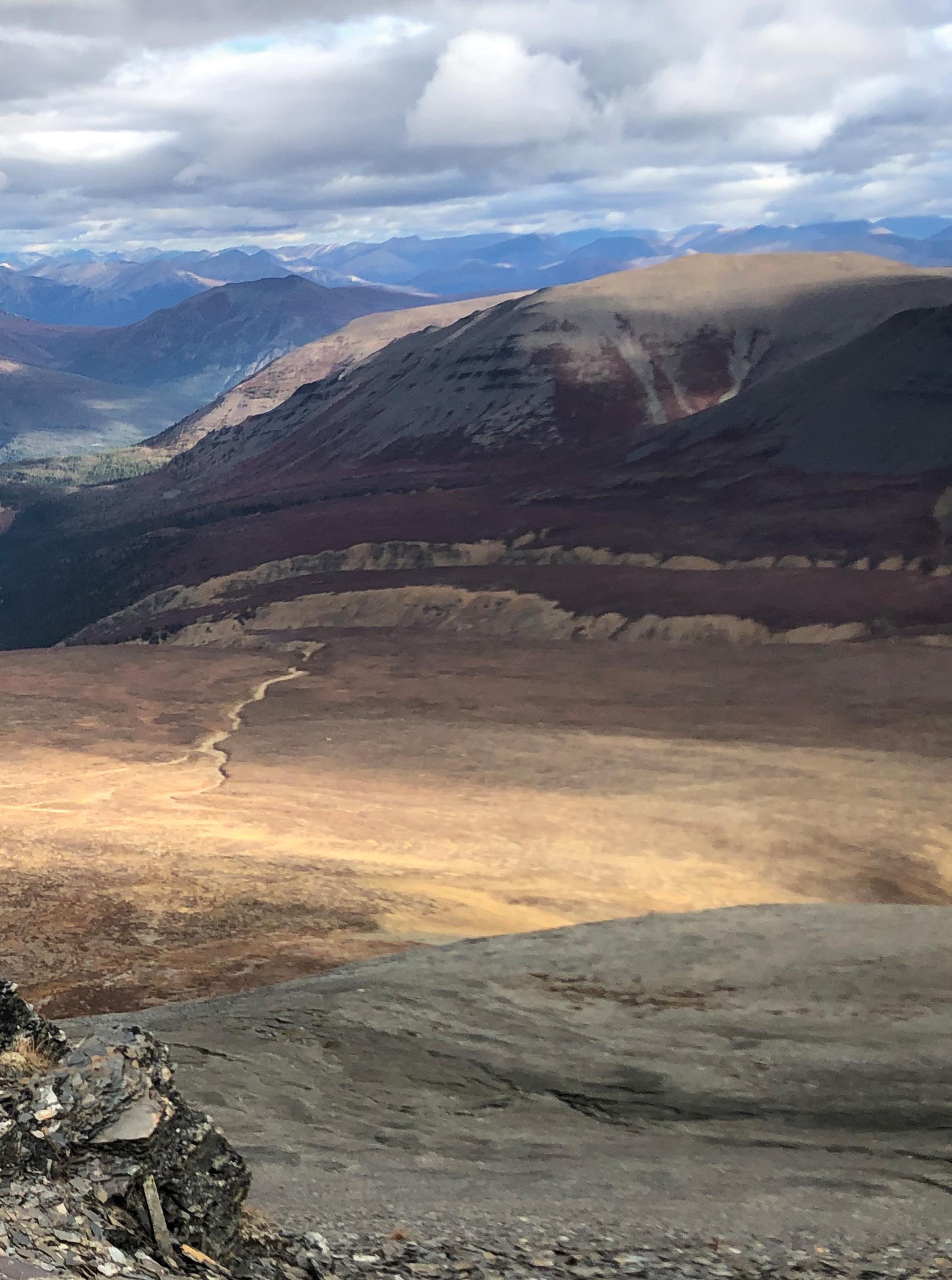
»
design forever. When John A.
standard soft point lead
thick hide with a well placed shot, he began working on what would eventually become
since revolutionized the bullet industry many times over with products such as the Solid Base,
many more. So even though the tried and true Partition will still take on any mud-caked Canadian
ammunition
from the factory.
Nosler.com BUT THE BEST CHOICE IS ALWAYS A NOSLER est. 1948 C M Y CM MY CY CMY K 2024 Nosler Sometimes Half page 3 Ad 7x4.8125.pdf 1 5/29/2024 4:14:23 PM
One mud-caked British Columbia bull in the fall of 1946 changed
modern bullet
Nosler's
bullets from his 300 H&H failed to penetrate the moose’s
the Partition bullet. Over 76 years later, Nosler has
Ballistic Tip,
AccuBond, Expansion Tip, and
moose with a well placed shot, there is a Nosler bullet created for every application and now
in loaded
right
The best just keeps getting better.
5. GPS UNIT
WHETHER YOUR BACKCOUNTRY adventure begins at the road’s end or at a fly-in lake, you need to be able to chart a route, stay on course and find your way back. A good handheld GPS unit can help you do all that and more, providing maps and satellite imagery of the area you intend to hunt, complete with waypoints.
Today’s units also monitor the weather, provide elevation data and offer an onboard compass as a navigation backup. They can even allow folks back home to follow your adventure via the location-tracking feature. Perhaps most importantly should you need to be rescued, many units can also send an SOS alert with your coordinates to emergency responders. Compact and weighing less than 10 ounces, a handheld GPS can offer hundreds of hours of battery life—and peace of mind.



AT THE END of a long day of trekking, no one needs the frustration of a tent that’s difficult to set up (or tough to pack back up in the morning). With that in mind, look for a model that’s either semifreestanding or freestanding, complete with a waterproof fly and floor with taped seams. It should also have at least one easy-access
door, a vestibule for storing gear, super-strong lightweight poles and reinforcements in key areas. As well, the tent must be able to withstand strong winds, and offer bug protection and plenty of ventilation. A one-person tent should weigh less than two pounds, while a two-person model should not weigh more than three.
7. SLEEPING
BAG
A DOWN MUMMY-STYLE sleeping bag with a baffle construction to keep the down evenly distributed is ideal. It should include a waterrepellent shell, and a jacket-style hood. It should also weigh less than three pounds and stuff into a sack no larger than 10 by 20 inches. And for a comfortable night’s sleep, also bring a compactible, self-inflating sleeping pad.
8. BOOTS

THE NUMBER ONE hiker’s injury is blistered feet, which can quickly shut down a hunt. To avoid this, make sure your boots are properly broken-in before heading offgrid. As with clothing, the time of the year will play a role in some aspects of your boot selection. On early-season hunts, go with non-insulated boots, but later in the season, select boots with suitable insulation for the lower temperatures.
I prefer leather boots of 10 inches in height for the additional support and rollover protection they provide in rocky or uneven terrain. Stream crossings are also more doable with a higher boot. Weight is another factor to consider, as even a light boot will feel like it has lead soles by the end of the day. That being said, performance trumps weight.

40 | OUTDOOR CANADA [ JULY/AUGUST 2024 ] WWW.OUTDOORCANADA.CA
MANUFACTURERS
6. TENT
Backcountry hunting boots must have completely waterproof and breathable liners to keep water out, but allow sweat and moisture to escape. They should also be able to resist abrasion in tough terrain, and have a padded tongue and an EVA midsole that maintains cushioning and won’t break down. As well, you want durable outsoles that can handle various types of terrain. To prevent unwanted foot movement, I prefer a lace-to-toe fit.

WHILE YOUR CHOICE of clothing and camo pattern depends on the time of year and the location of your hunt, layering is key, as it allows you to add or remove clothing to match the conditions. For a base layer, nothing beats merino wool. For mid- and outer layers, look for clothing that offers breathability, followed by comfort, durability, multi-directional stretch, packability and weather protection. It should also be lightweight. Bring extra socks, and whenever possible, start each day with a fresh pair, even if it means washing them and drying them on the back of your pack while you hike. And definitely don’t forget packable, lightweight rain gear.








BURRISOPTICS.COM DOWNLOAD BURRISCONNECT THE BURRIS ELIMINATOR 6 IS UNLIKE ANY OTHER SCOPE. COMBINING FOUR TOOLS INTO ONE ADVANCED OPTIC. ELIMINATING PROBLEMS, SO YOU CAN FOCUS ON THE SHOT. TRAIN FAR. HUNT RESPONSIBLY. DON’T MISS. ELIMINATOR 6
9. Apparel
10. Hunting Knife

WHETHER YOU PREFER fixed-blade or folding hunting knives, I will cut to the chase and suggest the two most useful blade styles to bring are the drop point and a gutting blade. I like the drop point because of its versatility and strength, while a gutting blade takes the guesswork out of opening up the body cavity; consider a knife that combines both (pictured). I also prefer a four-inch stainless-steel blade that’s hard enough to retain an edge, but also easy to sharpen. The three types of steel that top my list are VG-10, AUS-8 and that old classic, 440C. I also recommend a colourful, nonslip handle that fits your hand well and is easy to find if you set the knife aside while field dressing.

12. SUNDRY ESSENTIALS
WHILE PACKING LIGHT is a priority on any backcountry hunting trip, don’t leave home without a compact first aid kit, a headlamp and spare batteries, and a nylon tarp for covering your gear at night and keeping meat off the ground. You also want to bring a compact knife sharpener, nylon lashing rope, a camera (or smartphone), insect repellent if needed, game bags and, if weight permits, a lightweight spotting scope and rangefinder. And one more thing—don’t forget your ammunition! OC
CRESTON, B.C.’S MARK HOFFMAN HAS BEEN VENTURING INTO THE MOUNTAINS TO HUNT SINCE 1968.
Backcountry hunters may not burn that many calories, but when packing meat or ascending into sheep or goat country, they’ll be close. So, pack high-energy foods such as trail mix and energy bars, as well as electrolyte water enhancers. And plan your main meals around calorie-laden, freeze-dried foods, such as beef stroganoff with noodles in a cream sauce. And you want those meals to be flavourful,
PLAN FOR SUCCESS

because at the end of an exhausting day, you may have to force yourself to take the time to eat.
For cooking, eating and drinking, bring a mini stove, aluminum or titanium pots, cutlery and a cup. It should all fit in a carrying bag and collectively weigh about a pound. For lengthy stays in the backcountry, also bring extra fuel for your stove. And finally, bring a water container with an integrated water-purifying system to filter out contaminants and prevent parasitic infections such as giardiasis, commonly known as beaver fever.
Backcountry hunts can be very demanding, so it’s vital that you are in peak physical condition. Prior to my mountain hunts, I spend months hiking with loaded packs, jogging and climbing every set of stairs I can find. Also well before you head out, consider how you’re going to field dress and pack out the game you harvest. While boning and cutting the meat into packable sizes will help, you also need to establish how far you can realistically pack out a heavy load. For example, I set specific distances for various-sized game and never exceed them.
It’s also important to get to know your destination beforehand. Study satellite imagery, and talk to trappers, guides, game biologists or other hunters who know the area to help plan your route, select hunting areas and find access to drinking water. And, of course, opt for a time of year and location that will give you the best chance to harvest the game you want. Finally, hunt with a partner and hunt safe—if there’s ever an emergency, help will often be many hours away.


42 | OUTDOOR CANADA [ JULY/AUGUST 2024 ] WWW.OUTDOORCANADA.CA
MANUFACTURERS (GEAR); HUNTER (SAM JOHNSTONE)
WHY NOT BOTH ATVS FOR WORK OR FUN.

Can you have fun with something that’s also meant for work? Derek Verheyenis one of Honda Canada’s powersports and equipment experts. He says the company’s ATV design team has successfully closed the gap between work and play, and that typically leads to customer conversations that go well beyond a machine’s utility features. Enter the dual-use ATV.
According to Verheyen, the practicality and usefulness of a workhorse ATV is where discussions with potential customers typically start,but it’s not long before things move from business to pleasure.
“We get plenty of questions about jobs like hauling cords of wood out of the bush and plowing snow. Those are important considerations, but we don’t get any resistance when we mention that the same ATV is perfectly suited for trail riding to a favouritefishing spot, or for backwoods exploration.”
Honda knows very well that people searching for a “workfirst” ATV do their research before they arrive at a dealership. Then it’s the job of product experts to highlight commonly overlooked selling features. Verheyensays that’s when the focus shifts from work to the fun side of dual-use machines.
“We can talk all day about longitudinal engines and torquesensing differentials, but we also aim for what we call ‘woah, I didn’t think of that’ moments. That’s when the smiling starts.”

The following are Verheyen'sexamples of smile-inducing customer conversations that highlight practical and fun aspects of dual-use ATVs.
. Manual transmission ATVs offer power and control for hard work, while advanced automatic gearboxes provide additional versatility. They're perfect for hauling loads through mud, and ideal for novices exploring the backcountry without shifting gears. When thinking of an ATV as an investment, the ability to smoothly transition from tool to toy can be a valuable feature that keeps an ATV in the family for many years.
B
. Big horsepower and torque can make hill-climbing or working on gravel and loose soil easier. Just remember that the extra power comes in a bigger, heavier ATV package that will consume more fuel. It can also be harder to maneuver in tight spots. It may seem obvious to some,butask yourself if an ATV’s heft will actually fitdown the narrow, winding pass to a favouritewilderness retreat.
A Honda ATV dealer is an expert who can be kept on speed dial years after a purchase. They spend their weekends using their ATVs for work and play, making them a vital resource if customers run into a problem. If it’s a question about towing capacity or how to deal with a mechanical problem while camping kilometresaway from home, for example, they can probably help or find someone who can.
More of a post-purchase environmental tip is the fact that an ATV such as a Honda Rubicon 520is at home in many different environments. So, don’t forget about the plants and seeds picked up in the tires and undercarriage (also known as “hitchhikers”). Just as boats can spread zebra mussels and other invasive species, ATVs can carry noxious plants from one area to the next. So, take the time to scrub them after work and before and after a weekend of backcountry sightseeing.
T h e p o w e r t o c h o o s e
i g g e r i s n 't a l w a y s b e t t e r
o n 't d i t c h y o u r d e a l e r
D u a l - u s e A T V s d e s e r v e a b a t h
D
| h o n da . c a

RECIPE FOR

44 | OUTDOOR CANADA [ JULY/AUGUST 2024 ]
PATRICK WALSH
WHEN IT COMES TO TACKLING GIANT LAKERS—AND ENJOYING A HEALTHY TASTE OF THE FAR NORTH—THE N.W.T.’S REMOTE GREAT BEAR LAKE LODGE OFFERS THE FULL-MEAL DEAL

» SUCCESS
MICHAEL HUNTER GOT HIS FILL WITH A NEW PERSONALBEST LAKE TROUT
TBY PATRICK WALSH
THE DISTINCT ODOUR of surfacing baitfish fills the still morning air as we finally begin trolling after a 34kilometre run north from camp. All around us, Arctic terns dive and skim the surface of the dead-calm water, gorging on insects. It’s a good sign, I’m thinking. Surely the big fish will also be on the feed, and hungry for our enticingly wobbly Hawg Nose plugs running just 21 feet down.
Our guide is certainly confident. Reid Stoyberg has been scoping out the area, what he refers to as “The Bluffs,” all season long already, putting his lucky guests on fish in the process. But not just any fish. We’re on the hunt for lake trout, or more precisely, the so-called grey morphs, the largest of the four laker types found here on the N.W.T.’s Great Bear Lake. They are the piscivorous apex predators of this vast northern lake, filling their ample gullets with whitefish, Arctic grayling, ciscoes and hapless smaller trout. You won’t catch great numbers of these fish, but the ones you do land will typically be large.
The boat ride out from our cabins at
WWW.OUTDOORCANADA.CA | 45
Plummer’s Great Bear Lake Lodge was chilly, but we’re soon shedding layers as the sun beams down through the cloudless mid-July sky. It’s around 9 a.m., and already the surface temperature of the water is a relatively balmy 64°F, well above the seasonal norm in the 40s. The fish down in the much cooler water where our baits are running don’t seem to mind, though, and soon the action heats up, too.
In short order, I reel in two decent lakers in the 20-pound range, which we quickly release boatside. The other guest in our 18-foot custom-built Lund is Michael Hunter, my appointed fishing buddy for the week. Not to be outdone, he soon tightens up on a fish. Judging by the healthy bend in his rod, the head shakes and the peeling of line, it’s no 20-pounder this time.
Now, Michael is a big guy, the imposing head chef and owner of Antler, a popular Toronto bar and restaurant famed for its game-heavy menu (pan-roasted venison rack, anyone?). But even still, once he has his catch hoisted free of the net and held close for the obligatory quick photos, it’s clear this is one monster of a fish—all 45 pounds of it, according to Reid’s trusty scale. With that, the Hunter Chef, as he’s known on social media, declared he now had a new personal-best laker to his credit—“by far.”
If you’re after a trophy lake trout, and a bonus legitimate shot at catching a record-book fish, Great Bear Lake Lodge has all the key ingredients to make it happen. Just ask the Hunter Chef. As for me, this was my first return to Bear since my initial visit in 2008, giving me another crack at besting my own PB laker, a 37-pounder I caught even earlier back in 2005 on northern Saskatchewan’s Milton Lake. And despite my limited experience on Bear, I’m pretty sure I’ve got the goods on the legendary lake’s recipe for success.

There are a few reasons Great Bear’s lakers grow so darn big, and it all begins with geography. For starters, this is one giant body of water, spanning some 31,153 square kilometres. It’s the largest lake entirely within Canada, in fact, and the eighth largest freshwater lake on the planet. Given that, there’s an enormous amount of capacity for producing fish. And while the fish grow slowly here owing to the yearround frigid northern waters and shorter growing season, they also grow to be very old and, as a result, very large.
How old? Up to 60 years in many cases. And how large? Well, the official world record was caught on Bear, a 72-pounder hauled in by the late U.S. laker aficionado Lloyd Bull. That was in 1995. Then in 2000, angler Aivars Slucis pipped that with his unofficial new world record, weighing in at 78.85 pounds and stretching the tape to 53 inches. Imagine seeing that on the end of your line. Those freaks aside, respectably large fish continue to be routinely caught and released. One day during my visit last July, for
GUIDE REID STOYBERG KEPT THE CREW ON THE FISH
example, guest Garry Eekhoudt of Winnipeg boated a 55-pound beast, while his son, Daniel, recorded a 42. A few days later, Agissiz, B.C.’s Neal Trebink earned bragging rights with a 48-pounder. Awesome genetics are also clearly at play.
Another thing the trout have going for them on Bear is they’re largely left alone to slowly grow into giants. The lodge is way up there, on the lake’s northeast Dease Arm extending above the Arctic Circle. It’s Bear’s northernmost section of water, a 250-kilometre boat ride from the nearest (and only) community on the lake. That’s the Dene First Nations community of Déline, tucked into the Keith Arm, in the opposite southwest side of the lake. And there are only two other sportfishing operations on the lake, Trophy Lodge and the self-guided Arctic Circle Lodge, which are also run by Plummer’s and also accessible by air only. Combined, the three camps host a total of just 475 anglers maximum during the short fishing season running from late June to late August, and they’re each nestled in totally different arms of the lake. You must remember, too,
46 | OUTDOOR CANADA [ JULY/AUGUST 2024 ]
PATRICK WALSH (STOYBERG, ANGLERS); SANDRA CHEUNG (MAP)
there’s a ton of water to cover up there. Fishing pressure? Hardly.
Isolation aside, the one other major factor that allows Bear’s lakers to become lunkers is the way Plummer’s manages the fishery. Barbless hooks prevail here, as does the mandatory catch-andrelease of almost every fish. Only small trout, typically the abundant insect-eating redfin morphs, are kept for the occasional shorelunch. And the guides are rightfully sticklers in terms of handling the fish, preferring to hold the slippery giants for the more inexperienced guests when it’s time to quickly snap hero shots. Ugly gill grabs are strictly verboten. On Great Bear Lake, the trout demand, and receive, nothing less than the utmost respect.
Add it all together, and you can only come to one conclusion. For that, I defer to former long-time guide and now fisheries biologist Craig Blackie, who wrote his PhD thesis at Dalhousie University on Bear’s lakers. “Anyone who knows anything about trophy lake trout,” he says, “knows that Great Bear Lake produces the largest trout in the world.” And there you have it.






»A BIG LAKER FOR SLY TRUDEL AND GUIDE ED LEDIN
Trophy Lodge
Great Bear Lake Lodge
Deline
S N W E
Arctic Circle
GREAT BEAR LAKE
WWW.OUTDOORCANADA.CA | 47
Arctic Circle Lodge
N.W.T
Yellowknife
NUNAVUT
YUKON





For sure, the unreal fishing is the main course for anglers venturing to Bear—it’s virtually impossible not to catch trout, even without really trying. The same goes for the lake’s super-aggressive northern pike, averaging five to 10 pounds, but sometimes hitting the 30-pound mark. Fishing for them really is a numbers game—expect to catch upwards of 100 in a day. The trick is to avoid wasting time on the sneaky hammer-handles when it’s the big gators you’ve got your sights on. As for Michael and me, we preferred to exclusively chase lakers during our four and a half days on the water (punctuated by a two-day fly-out to fish for Arctic char on the Tree River in neighbouring Nunavut). In particular, I was focused on the hunt for that new PB trout of my own. Arctic grayling also feature on the fishing menu, and they’re equally abundant and aggressive. One day during a shorelunch break at a spot called Limestone Point, Michael and I obligingly grabbed some light
spinning gear to catch a few of these giant-finned beauties to supplement the small trout we’d kept earlier. Fishing from the shoreline, I caught-and-released three dink trout in less than half an hour, as well as 10 or so grayling, keeping a couple for the pan. At one point, what looked to be a 15-pound laker stormed in and T-boned a struggling grayling I’d just released in the shallows. Nature at work.
Nature was also at work above the gin-clear water’s calm surface, with squawking herring gulls aggressively competing for the discarded fish remains. All around me throughout my time on Bear, in fact, nature abounded, and to me, just having the opportunity to get a taste of this unique Far North ecosystem was a treat all on its own. Along with the gulls and terns, I also saw long-tailed jaegers, Arctic terns, Bonaparte’s gulls, white-winged scoters and Arctic loons. That was just scratching the surface, though.
Fellow guest Greg Seegert, a retired ichthyologist from Wisconsin, has been coming to Bear since 2014 to fish, as well as to birdwatch. Lodge manager Chuk Coulter, who

48 OUTDOOR CANADA WINTER 2012 WWW.OUTDOORCANADA.CA
GET OUTDOORS
Order online outdoorcanada.ca/subscribe Call 1-800-663-7611 service@outdoorgroupmedia.com MAILED RIGHT TO YOUR DOOR 48 | OUTDOOR CANADA [ JULY/AUGUST 2024 ]
ALL YEAR LONG
ARCTIC GRAYLING MADE FOR GREAT SHORELINE SPORT
AND MICHAEL HUNTER

has penchant for assigning everyone a nickname, calls him “Birdman,” and for good reason. Always at the ready with his binos, Seegert has spotted 80 different bird species on Bear over the years, his most prized sightings including threetoed woodpeckers, king eiders, golden eagles, snowy owls and five species of loon. “It has a unique fauna, and includes birds most birders have never seen, or maybe only a time or two,” he tells me.
On the ground, meanwhile, guests shouldn’t be surprised to see any number of creatures inhabiting this region of the northern boreal forest, known as the Sahtu. Amid the stunted stands of black spruce and tamarack, barren-ground grizzlies, muskox, wolves, moose and more traverse the Precambrian granite, navigating the dwarf birch, willow and peat bogs dotting the stark landscape.
If you’re nerdy about all this kind of flora and fauna stuff, like I am, it’s a nerdy paradise, right down to the vibrant pinky-purple fireweed just outside my cabin door back at camp. And if you’re at Bear in mid-July like I was, the sun never sinks below the horizon, giving you ample time to get your fill. At a certain point, the line blurs between whether the unreal fishing or simply experiencing this part of the world is the entrée or the starter.
The first time I visited Great Bear Lake Lodge, I knew no one. On this trip, however, I was lucky enough to have teamed up with Michael, as well as George Wallace and his buddy Sly Trudel, an ex-military man with our shared passion for fishing. They shared a boat with guide Ed Ledin. Throughout our time on Bear, our two boats largely plied the water within sight of one another, and we dined, had cocktails and compared notes together back at the lodge at the end of each day. I first met George 20 years ago when he was general manager of the first-ever Bass Pro Shops outlet in Canada, the Outdoor World in Vaughan, Ontario, and we’ve been friends ever since. Now the GM of the Beretta-brand distributor Stoeger Canada, he’s fished at the lodge eight times, twice with his dad and two younger brothers. For George, the outstanding fishing is just one of the main ingredients that keeps luring him back.
So, what else is in the mix? I put that question to George one evening on the deck back at the lodge. “Honestly, I would say the isolation. I like my alone time. No phone,” he tells
me. “It’s also the peace and tranquility. No sirens. No people yammering. No hum of traffic.” George lives in hectic midtown Toronto, so I get it, having worked down there myself back in the day. As we continued talking, a pair of loons cried out in the distance, as if on cue.
When it comes to chasing lakers on Bear, meanwhile, George has a rather philosophical take. “It’s world-class fishing, but there are so many variables. Indeed, luck. Do I come here to catch a big fish?” he says. “No, but knowing I could is great.”
Inside the lodge, meanwhile, the weekly wine-and-cheese mixer for staff and guests was getting underway, featuring some tasty bites assembled by Michael and the kitchen’s Red Seal chef, Tony Glasgow. And that brings us to the most important ingredient in Bear’s recipe for success: the 35 folks who keep the place running.
During my visit, that included everyone from support staff manager Maureen “Mama Mo” McNeilage, who prepared fresh-baked pastries every morning, to nine-season vet Kate Bollum behind the bar (she is a school teacher during the
MICHAEL HUNTER (ARCTIC GRAYLING); GBL STAFF (GROUP PHOTO) WWW.OUTDOORCANADA.CA | 49
FISHING FRIENDS (LEFT TO RIGHT)
GEORGE WALLACE, SLY TRUDEL, CHUK COULTER, PATRICK WALSH, CHUMMY PLUMMER

off-season) to the attentive dining room servers and the shop guys keeping the 40-horse Mercs purring. And managing it all, often with a clipboard in hand and a sly quip or two at the ready, was Chuk, who also oversees Plummer’s other operations on Bear, the Tree River and Great Slave Lake to the south.
As George says, “The people are great up there. They look after you.” And perhaps no one takes better care of you at Bear than the fishing guides. That was unquestionably the case with our guide. An environmental scientist back home in Lloyminster, Alberta, Reid has been guiding at Bear for 11 years now. And as head guide, he definitely knows where to find the trophies, and how to catch them. Unlike George, I wasn’t so Zen about the angling prospects at Bear. No, I wanted to catch big fish. More importantly, I really wanted to catch that new personal-best, and Reid seemed

50 OUTDOOR CANADA WINTER 2012 WWW.OUTDOORCANADA.CA 50 OUTDOOR CANADA WINTER 2012
MICHAEL HUNTER
(WALSH & LAKER); CHUK
COULTER
C M Y CM MY CY CMY K Outdoor Canada Summer 2024F.pdf 1 2024-05-26 6:51 PM
41-POUNDER
(GREAT BEAR LAKE LODGE)
PATRICK WALSH AND HIS NEW PB, A
quite confident we could make it happen.
And happen it did, on just our second full day of fishing. Plying an area the guides call the “Fish Tank,” Reid determinedly put Mike and me on the fish. Remember, hunting for the giant grey morphs is not a numbers proposition, but by the time we headed back to camp, we had put a respectable 21 lakers in the boat. Along with several 20-pound-plus beauties and three double-headers, that included my new PB, a 41-pound silver beast I enticed with a pink Hawg Nose in 50 feet of water. Recipe for success, indeed.
In the end, I’d like to say I had my fill. But the truth is, by the time I climbed aboard the ATR twin turboprop for the flight back to Yellowknife, then home, I was only left craving more. OC
EDITOR-IN-CHIEF PATRICK WALSH HAS AN INSATIABLE APPETITE FOR CATCHING AND RELEASING BIG FISH.
LODGE LEGACY
FULL DISCLOSURE: I am good friends with Chuk Coulter, the overall general manager of Plummer’s Arctic Lodges, who also serves as lodge manager at Great Bear. Then again, everyone who meets Chuk believes they are good friends with Chuk. He’s just that type of gregarious guy. We originally met during my first visit to Bear in 2008, when he was assigned to be my guide. He had been guiding for four seasons already at the time, and would continue guiding until 2011, when he was promoted to lodge manager. At any rate, I learned a lot about fishing for big lakers from Chuk—he calls it hunting—and had a blast in the process. In the story I wrote back then, I described him as “gung ho.” He still is, and that’s a good thing.
This past April, the owner of Plummer’s Arctic Lodges, 81-year-old Chummy Plummer, announced it was time for him to step back and sell the operation. Among the group of four new owners? Chuk Coulter. The other three partners include former Plummer’s GM Shane Jonker, former veteran guide Bobby Richardson and long-time regular guest Herb Fritch. Was it


»difficult for Chummy to let go of an enterprise that had been in his family since day one back in 1949? Not with this new team in place, he says.
“The lodges will remain in good hands with folks who truly love the place, and who have built careers and families around it,” Chummy wrote in the Plummer’s newsletter. “I feel good knowing what myself, my dad and my grandfather have built will continue to operate and offer the same high level of service we have been offering for over 75 years. The Plummer’s name will live on as the finest fly-in fishing operation in the North.” If I know Chuk, he will make sure of that.


SV 70 The smallest low profile yet. For anglers seeking even greater palming comfort. HYPERDRIVE DESIGN For more info visit: Daiwa.us TATULA SV SERIES REELS ANYTHING LESS AND YOU’LL FACE THE BACKLASH SV TECHNOLOGY MAKES CASTING LIGHT WEIGHT BAITS EASIER, WITH FEWER BACKLASHES. TATULA® SV Original SV frame Corrosion-resistant ball bearings TATULA® SV TW Small frame size SCAN HERE TO SEE TATULA SV VIDEO
TATULA®
BY KEN BAILEY


52 | OUTDOOR CANADA [ JULY/AUGUST 2024 ] SPECIAL REPORT


WE ALL KNOW hunters are, first and foremost, conservationists. In the early decades of the 20th century, after all, it was hunters who lobbied for more stringent harvest regulations to save numerous species, including antelope, elk and waterfowl, from catastrophic declines due to market hunting. In the century since, we’ve led countless more initiatives to conserve wildlife and wildlife habitat, willingly putting our time, energy and dollars to important use. We’ve also endorsed regulatory and behavioural changes whenever science has told us our wildlife are imperiled.
The threats seem to never end, however, and newly emerging information suggests we’re now facing yet another. And it’s a threat many of us thought we had already put behind us: lead.

THE SHOTSHELL SITUATION
Lead is a toxic natural element that’s long been known to cause serious health problems in humans, particularly developmental delays in children. It can be found in everything from batteries to water pipes to household dust, and prolonged contact can even be fatal. Wildlife are also not immune. Within both the hunting and scientific communities, the poisoning of birds as a result of ingesting lead pellets has been recognized for more than a century.
As recently as the 1980s, according
WWW.OUTDOORCANADA.CA | 53 »
to the Canadian Wildlife Service, it was estimated up to six million of the 50 to 60 million ducks migrating from Canada every fall had ingested at least one spent lead pellet. An estimated 200,000 to 360,000 of those birds died, while several million suffered sub-lethal lead poisoning. South of the border, meanwhile, the U.S. Fish and Wildlife Service estimated that two to three per cent of the continental waterfowl population—more than one million birds—died annually of lead poisoning from ingesting spent shot.
In response, the U.S. and Canada banned the use of lead shot for waterfowl hunting in the 1990s. The hunting community wasn’t happy with the legislation, in part because the replacement steel ammunition of the day performed poorly compared with lead. Over time, however, the ammunition industry invested in research and technology, making significant improvements. As a result, today’s waterfowlers have numerous non-toxic options, many of which outperform lead. While it was controversial at the time, the banning of lead shot for waterfowling appears to have worked—a study of black ducks in the eastern U.S., for example, revealed the percentage of ducks with toxic blood levels declined from 19 per cent in 1978 to just one per cent in 2017. At the same time, however, hunters are still permitted to use lead shot for upland game birds. Although we seldom associate the harmful effects of spent lead shot with upland birds, research in New Brunswick, South Dakota, Utah and elsewhere has shown that some woodcock, pheasant and quail populations have elevated lead concentrations consistent with consuming lead pellets. In one study, scientists fed three groups of bobwhite quail with one, five and 10 pellets, respectively; the groups that were fed five or 10 pellets exhibited health declines within seven to 14 days. And a 2015 study in South Dakota showed that wild pheasants living in areas with artificially high hunting intensity—near release sites, for example—faced an elevated risk of lead exposure and poisoning.


Here in Canada, the way upland birds occupy their habitat, and the density of hunters, suggests most birds are unlikely to encounter spent lead shot, but the risk can’t be completely ignored. Far more worrisome is the potential harm to wildlife from lead-core rifle ammunition.
THE BULLET FACTOR
Recent studies from North America, Europe and Australia tell us that birds are also being poisoned by lead fragments from rifle ammunition after scavenging on the remains of hunter-shot animals. That includes the viscera and other discarded portions of animals cleaned in the field, as well as wounded and lost animals that eventually die.
STUDIES SHOW BALD EAGLES AND OTHER SCAVENGERS HAVE BEEN POISONED BY LEAD FRAGMENTS IN THE REMAINS OF HUNTER-SHOT GAME ANIMALS
Take bald eagles, for example, one of North America’s most iconic birds. Study after study from across Canada and the U.S. has warned they are accumulating toxic levels of lead in their blood, liver and/or bones, with overwhelming evidence pointing to lead ammo as the major source.
In fact, an analysis in Canada of “found-dead” birds showed that up to 15 per cent of the bald and golden eagles examined had lead levels exceeding the toxic-risk threshold. Beyond bald and golden eagles, the birds most frequently harmed by lead include vultures and other raptors, as well as the corvid family, especially ravens and magpies.
John Chételat, a research scientist with Environment and Climate
54 | OUTDOOR CANADA [ JULY/AUGUST 2024 ]
Change Canada (ECCC), has been studying lead exposure in scavenging birds across the country since 2018. He says the effects on birds that ingest lead include lethargy, muscle wastage, wing droop, diminished balance and coordination, increased susceptibility to diseases and parasites, poorer reproduction and, in some cases, death.
While Chételat notes that scientists know considerably less about the effects of lead exposure on furbearers, there’s no doubt they are also feeding on the carcasses of rifle-shot game. In a Saskatchewan study under the supervision of ECCC scientist Kirsty Gurney, a researcher set up a camera over the remains of white-tailed deer and found that magpies were the most common scavenger. Ravens, crows, bald eagles, great-horned owls and broad-winged hawks were also observed, along with coyotes, foxes, fishers, weasels, raccoons and even cougars. Similar studies have shown wolves and bears are also common scavengers of gut piles and discarded carcasses.
So, just how much lead contamination can be found in the carcass of a hunter-shot animal? Using sophisticated synchrotron X-ray technology, a 2022 study from the University of Saskatchewan demonstrated that thousands of tiny lead fragments, many smaller than 1⁄100 of a millimetre, can travel as far as 18 inches into the flesh beyond the obvious wound channel. That means there are also human ramifications to consider.
Although there are no known incidents of acute lead poisoning in humans due to eating game shot with lead-core ammunition, several studies have revealed increased levels of lead in the blood of those who regularly consume wild meat. If you’re concerned about unwittingly ingesting lead particles, the science suggests you should be trimming away a greater area around the wound channel than most of us typically do.
Another link between lead bullet fragments and scavenging birds and mammals is the vast number of ground squirrels and their relatives
that are shot as agricultural pests, especially across the prairies. Invariably they’re left where they fall, with most hunters believing they’re actually doing the local hawks and owls a favour; it’s difficult to imagine how many such varmints are shot each year, and how many scavenging birds and mammals are affected as a result.
To be clear, the effect of lead ingestion varies between birds and mammals, as well as among species within each group. Several other factors, including sex and age, also influence how much lead is absorbed into the body and accumulated in tissues. Along with the amount of lead, the toxic effect is also influenced by the duration of exposure, the species’ sensitivity, and the overall health of the animal.
THE NON-TOXIC ALTERNATIVES
Lead has always been a good choice in hunting ammunition—it’s readily available, inexpensive, dense, and easily formed into a variety of shapes and sizes. It also possesses excellent ballistic properties, making it the standard for hunting bullets for well over a century.
The first lead-free rifle ammunition readily available to the hunting community was the Barnes X Bullet, introduced in 1989. It was created by Randy Brooks, the owner of Barnes Bullets, who was inspired during an Alaskan bear hunt to construct an all-copper bullet—without a jacket or lead core—that would


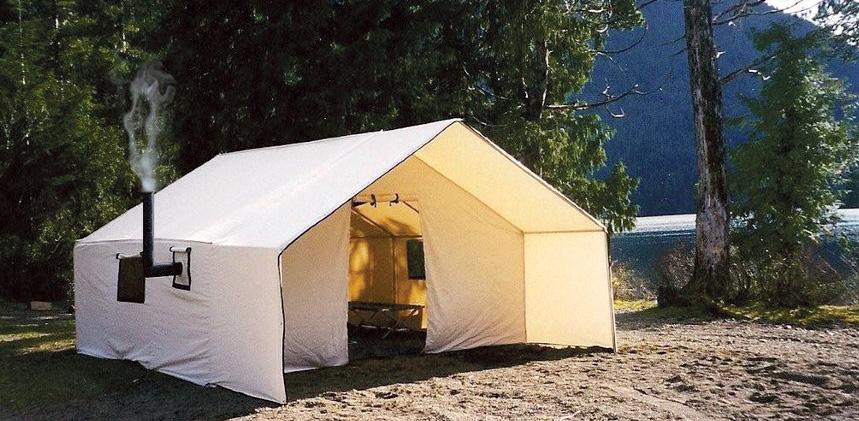

WWW.OUTDOORCANADA.CA | 55
KEN BAILEY (FIELD DRESSING); LYNSEY BENT (BALD EAGLE); BARNES BULLETS (RANDY BROOKS)
FREE SHIPPING IN CANADA with some restrictions deluxe wall tents www.deluxewalltents.com perry@deluxewalltents.com 250-704-2534 H custom wall tents H wood stoves aluminum frames H tarps H game bags H bedrolls H diesel heaters H cots FOLLOW US ONLINE @SPORTSMANCANADA CANADA » RANDY BROOKS OF BARNES BULLETS PIONEERED LEADFREE RIFLE AMMO
provide more reliable and consistent terminal performance. Looking back, it’s interesting to note that Brooks didn’t develop this innovative bullet for its environmental or health-related benefits, but for its performance. I can’t imagine he had any idea at the time just how influential his idea would become.
Often referred to as “monolithic” or “monometal” bullets, inferring they’re made with a single material (copper), many of today’s offerings are actually constructed of a copper alloy, usually incorporating zinc. Whatever the case, these bullets are becoming increasingly popular in the marketplace.
At this year’s Shooting, Hunting and Outdoor Trade Show, for example, I checked out the latest offerings from the Kinetic Group, the parent company of Federal, Remington, CCI and HEVI-Shot, among other ammunition brands. Of the new products being promoted, one
GETTING THE LEAD OUT
LAUNCHED IN 1989, THE BARNES X BULLET WAS THE FIRST LEADFREE BULLET FOR HUNTING TO GO ON THE MARKET

of just two new Federal big-game bullets was an all-copper shotgun slug, while Remington’s only new big-game offering was a cartridge featuring a copper alloy bullet. (Federal also introduced a new steel and
bismuth shotshell for upland birds, while HEVI-Shot showcased its new all-steel upland loads.)
The direction the industry is taking is clear, and as a Kinetic Group spokesperson explained, “We make many, many types of ammunition based on our customers’ needs and preferences. Market trends and demands show a growing need for various types of ammunition, and we’re delivering.”
THE NON-TOXIC DRAWBACKS
Initially, hunters did not embrace lead-free rifle ammunition. The earliest iterations suffered from inconsistent patterning, excessive barrel fouling, relatively poor accuracy, unreliable expansion, high prices and limited availability. Over time, however, many of those limitations have been overcome through continued research and development.
The inclusion of cannelures—the
Virtually all of the major ammunition manufacturers now offer one or more factoryloaded, non-toxic rifle cartridge line for hunting. The lead-free options for muzzleloader bullets, shotgun slugs and rimfire rounds, meanwhile, are more limited, but growing with time. The following are among the most popular lead-free cartridge options now available for rifle hunters.

BARNES BULLETS
• VOR-TX Rifle

FEDERAL
• Premium Trophy Copper
• Power-Shok Copper Rifle

SAKO
• Powerhead Blade
• Premium line with Barnes TSX bullets

REMINGTON
• Premier CuT

HORNADY
• Outfitter Ammunition
• MonoFlex LEVERevolution

WINCHESTER
• Copper Impact
• Varmint LF
• Varmint X Lead-Free
• NTX Superformance Varmint

NORMA
• ECOSTRIKE
• EVOSTRIKE


NOSLER
• Expansion Tip
• Ballistic Tip LeadFree Varmint
WEATHERBY
• Select Plus, loaded with Barnes TTSX bullets
56 OUTDOOR CANADA WINTER 2012 WWW.OUTDOORCANADA.CA
56 | OUTDOOR CANADA [ JULY/AUGUST 2024 ]
horizontal grooves in bullets—has eliminated the excessive fouling and pressure issues, for example, while concurrently improving accuracy and the ballistic coefficient (the measure of a bullet’s ability to overcome air resistance and maintain velocity for a flatter trajectory). While it’s fair to say that even the latest monolithic bullets aren’t as inherently accurate as lead-core bullets, the differences are minimal, and certainly not meaningful at typical shooting distances for game.
Although there’s still considerable uncertainty among hunters when it comes to penetration, the fact is monolithic bullets tend to penetrate deeper than lead-core bullets of the
same weight and calibre. That makes them particularly effective on larger animals. It also allows hunters to select a lighter copper bullet and expect similar penetration, but with reduced recoil.
Another characteristic of monometal bullets is they’re tougher than lead-core bullets, typically retaining 100 per cent of their weight after impact. That makes them especially effective when you need to smash through bone to get to an animal’s vitals.
T.J. SCHWANKY HAS HAD MUCH SUCCESS USING MONOMETALS








WWW.OUTDOORCANADA.CA | 57 Check our website for a dealer near you fishingbutler.com 905.807.3221 • Adjustable • Locking • Floats ULTIMATE FISHING ROD TIES FOR ALL YOUR SPORT SHOOTING NEEDS » MANUFACTURERS (AMMO BOXES); BARNES BULLETS (BARNES X BULLET); T.J. SCHWANKY (SCHWANKY)
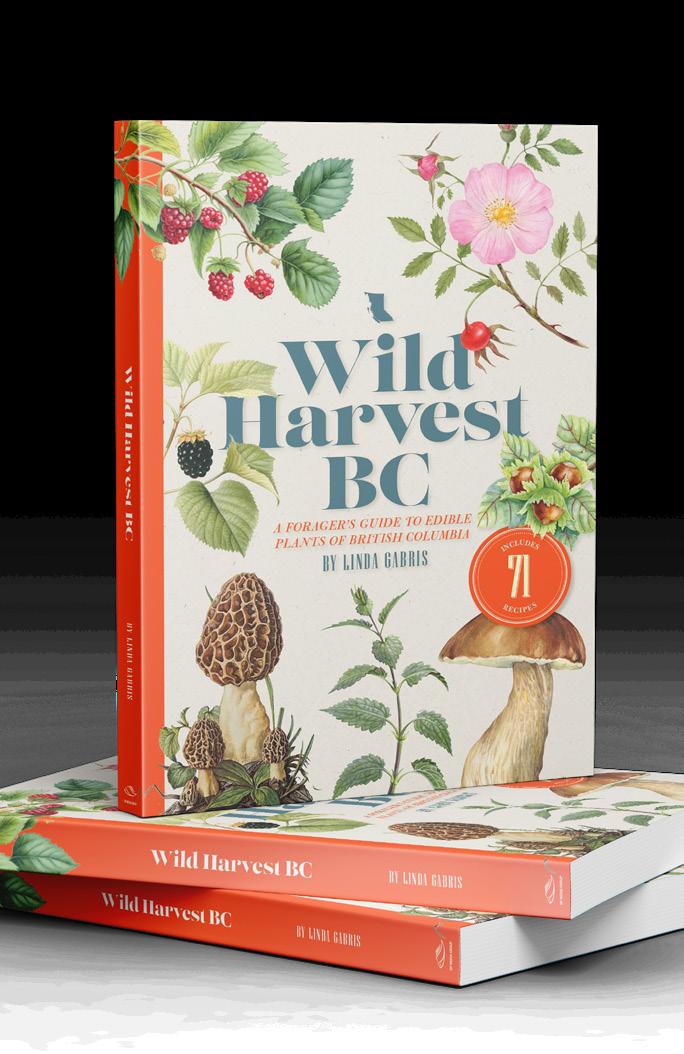
WILD HARVEST BC
A forager’s guide to edible plants of British Columbia
By Linda Gabris
Linda Gabris has been venturing into the outdoors to harvest wild edibles for over 60 years. The lessons taught to her by her grandparents, of responsibility, sustainability and a connection to the land are as important today as they were then. This book shares those lessons as well as tips and practical advice in a personal, easy-to-read style. Combined with a scientific field guide, Wild Harvest BC is the perfect companion book to take with you on your outdoor adventures.

If you only hit soft issue with a copper bullet, however, expect the animal to run farther than it would if similarly hit with a lead-core round; traditional cup-and-core bullets fragment considerably, creating a larger wound channel and more bleeding.
In my limited experience hunting game with lead-free rifle ammunition—taking 10 or so African animals ranging in size from springbok up to eland, and another three or four white-tailed deer—it performed well. I readily acknowledge that is a rather small sample size, however, so I reached out to fellow Outdoor Canada contributor T.J. Schwanky. He has successfully taken more than 100 animals across North America and Africa using various monometal bullets, never losing one that was hit properly.
If lead-free bullets have an Achille’s heel, it’s that they have a need for speed; reliable expansion can be a problem with them when impact velocities fall below the 1,800 fps to 2,000 fps range. That makes monometals an unsuitable choice for hunters who expect to make shots at extended distances. Having said that, a typical 130-grain, .270 Win. bullet will travel in excess of 2,000 fps to beyond 500 yards, a distance at which only the most capable shooters should ever take an animal anyway.
As for the problem of limited availability of monometal bullets, that is waning over time. Granted, it helps if you live in a large centre with dedicated big-box hunting stores that can afford to carry large ammo inventories. I recently perused the shelves of my nearest Cabela’s, for example, and found a reasonable supply of lead-free bullets from a range of manufacturers, although not all calibres or bullet weights were represented; to be fair, that was in February, so there will likely be more options available leading into the fall hunting season.
If you hunt with a muzzleloader or a shotgun, meanwhile, or like to tackle the local vermin population
with a rimfire rifle, the availability and variety of lead-free ammunition is more limited. But it’s out there if you are persistent in your search. As for the cost, we all know rifle ammunition of all flavours is getting expensive these days. Still, I found the monometal options to be on par, price-wise, with most premium brands and lines of leadcore ammunition.
THE LEAD-FREE FUTURE
As it stands, it appears Canada’s hunting community is gaining confidence in monolithics. In a 2018 membership survey, for example, the Ontario Federation of Anglers and Hunters found that a full 20 per cent of respondents had purchased lead-free ammunition for applications other than waterfowling. Looking forward, we should expect that manufacturers will develop even better lead-free rifle bullets, just as they’ve done with non-toxic shotshells.
What I hope won’t happen, and what I don’t think is necessary, is the institution of regulations mandating the use of lead-free rifle ammunition in Canada. To date, California is the only North American jurisdiction to have banned all lead ammunition, and I’ve yet to hear anything suggesting other states or provinces are contemplating similar legislation.
None of us needs to be told that lead is bad for the environment and our health; that’s why most consumer products, including gasoline and paint, no longer contain lead, after all. And again, as hunters we’re the ultimate conservationists, and none of us wants to impart harm unnecessarily on wildlife of any description. So, as we learn more about the negative impacts of lead-core bullets on non-targeted wildlife, and as the performance and availability of monometals continue to improve, I’m confident we’ll see a steady, voluntary migration toward a leadfree future. OC
HUNTING EDITOR KEN BAILEY IS INCREASINGLY USING LEAD-FREE AMMUNITION FOR ALL HUNTING.
58 OUTDOOR CANADA WINTER 2012 WWW.OUTDOORCANADA.CA
58 | OUTDOOR CANADA [ JULY/AUGUST 2024 ] NEW FOR 2024
$24 95 SHOP NOW Get your copy from our online bookstore: thebookshack.ca Call 1.800.663.7611













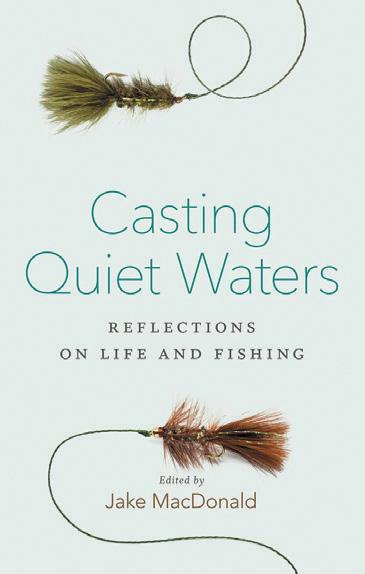
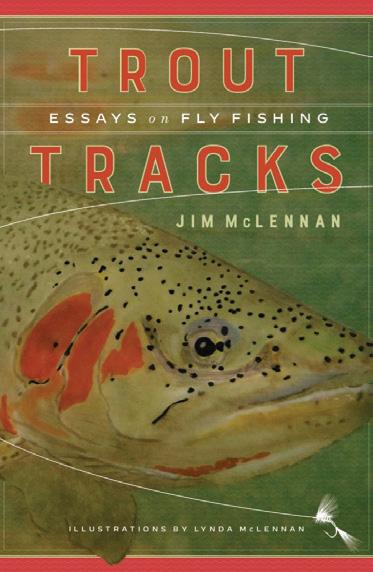

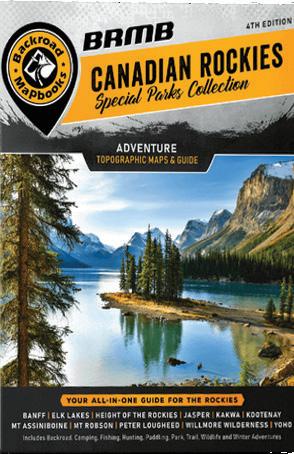
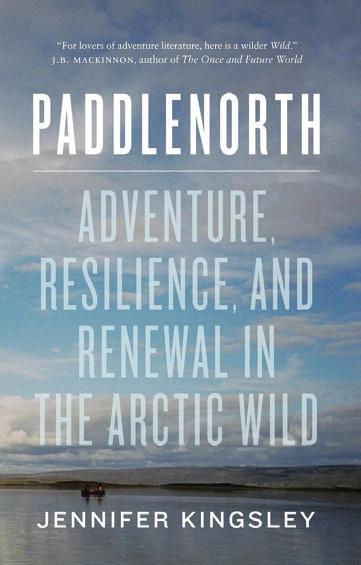
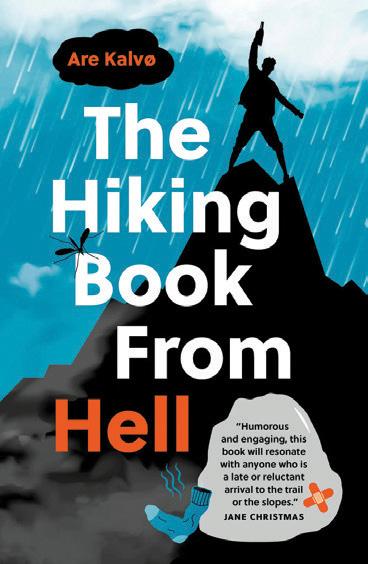







Fishing LOCAL AUTHORS • LOCAL TOPICS Outdoor Adventure Nature Because you Love Outdoor Canada, you may also enjoy these titles: Flies WITH PHIL ROWLEY & FRIENDS By Phil Rowley $29 By Phil Rowley Flies Published by thebookshack.ca Visit Our Bookstore For More Great Reading! 1-800-663-7611

sors



60 | OUTDOOR CANADA [ JULY/AUGUST 2024 ]
awesome
winners. FISHING HUNTING FAMILY WILDLIFE & WILD PLACES WE ARE NOW ACCEPTING ENTRIES FOR THE 14TH ANNUAL OUTDOOR CANADA PHOTO CONTEST ! PLEASE SEE PAGE 21 FOR ALL THE DETAILS THE TOP IMAGES FROM OUR ANNUAL COMPETITION HONOURING FISHING, HUNTING, FAMILY ADVENTURE AND WILDLIFE AND WILD PLACES IN CANADA ANNUAL PHOTO CONTEST 13TH BEST SHOTS! YOUR 1ST
PRIZE SPONSORS Many thanks to our contest spon-
13 Fishing, Zeiss, Berkley and VSSL for generously providing the
prizes for the
WITH THE PREVALENCE of smartphones and digital cameras these days, it’s no wonder Canadians are capturing so many fun and exciting images of their outdoor adventures. Of course, that makes it tougher than ever to judge our annual photo contest. It’s a labour of love for us, however, and we feel honoured you’ve shared so many memorable outdoor moments from across this great land. Congratulations to this year’s winners and runners-up, and thanks to all who entered. And please keep on clicking those shutters—we look forward to next year’s awesome crop of photos. —THE EDITORS
1ST PLACE
PHOTOGRAPHER: Julie Dano
WHERE: Thelon River, Nunavut
WHEN: July 2023
DETAILS: On a 40-day, 950-kilometre canoe expedition down the Thelon River through the Barren Lands of Nunavut and the N.W.T., Julie Dano and her husband, Jeff, caught hundreds of lakers and Arctic grayling. But when Jeff hooked this 41-inch trout, they had to beach their canoe to safely land the fish. As the photo shows, the bugs were thick, but Julie says the fishing and incredible scenery made it all worthwhile.
PRIZE: $500 13 FISHING ROD, REEL & GEAR PACK
FISHING
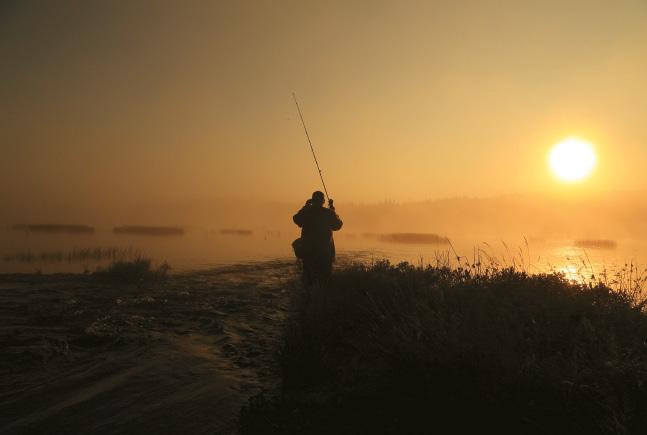

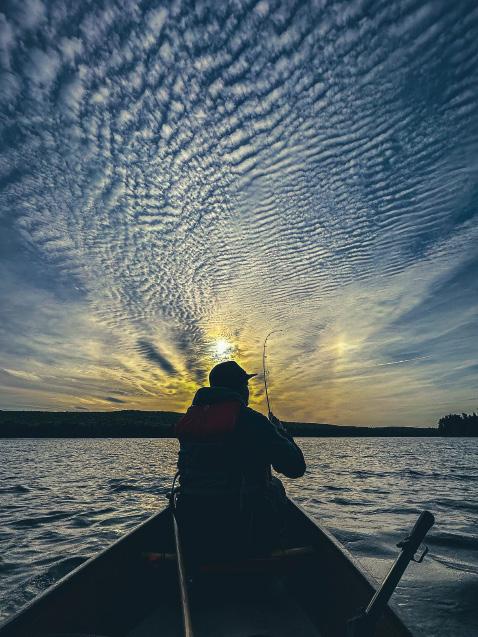
3RD PLACE
PHOTOGRAPHER: David Moore
2ND PLACE
PHOTOGRAPHER: Cindy “Charly” Vojin
WHERE: Coles Pond, Newfoundland and Labrador
WHEN: September 2023
DETAILS: Charly Vojin was on a foggy, early-morning walk when she saw a local angler land several fish in quick succession. The rising sun, golden light and silhouetted figure combined for a beautiful moment, and Charly was right there to shoot it. The photo doesn’t tell the whole story, though. “The gurgling waters and the sounds of loons completed this wonderful setting I was lucky to find myself in,” she says.
PRIZE: $250 13 FISHING ROD, REEL & GEAR PACK
WHERE: Algonquin Provincial Park, Ontario
WHEN: May 2023
DETAILS: After several days of portaging and camping in Algonquin’s interior, everyone in David Moore’s group had caught trout except him. Finally, he landed a pair of nice lakers, and was heading back to camp when this scene presented itself. “I had this incredible angle of my paddling partner, Jon, silhouetted by the sunset with the clouds forming this wonderful pattern,” David says. “It was truly a magical evening.”
PRIZE: $100 13 FISHING ROD, REEL & GEAR PACK
SPONSORED BY WWW.OUTDOORCANADA.CA | 61
SEE THE HONOURABLE MENTIONS AT WWW.OUTDOORCANADA.CA/2023HM. 8
2ND 3RD PHOTOS DEPICTING ANY ASPECT OF SPORTFISHING IN CANADA



1ST PLACE
PHOTOGRAPHER: Jerry Joseph
WHERE: Livingstone-Porcupine Hills, Alberta
WHEN: October 2023
DETAILS: Jerry Joseph was hunting for sharp-tailed grouse in the foothills southwest of Calgary when he photographed his friend Amy pausing to praise her 2½-year-old pudelpointer, Newt, during a challenging hunt for an unfamiliar species. Jerry was carrying both his 12-gauge over-under shotgun and his camera at the time. “Managing both was a little difficult,” he says, “but the series of photos I got was well worth it.”
PRIZE: ZEISS 10X42 CONQUEST HD BINOCULARS
2ND PLACE
PHOTOGRAPHER: James McGregor
WHERE: Southeast Saskatchewan
WHEN: October 2023
DETAILS: After limiting out on ringnecks, avid angler and hunter James McGregor pulled out his phone to shoot a picture of this memorable moment. Along with the birds, the shot features his family of hunting dogs: 13-year-old Storm with her daughter Briar and granddaughter Sage. James says he didn’t intend for them to line up so neatly—that’s just how they ended up when he finally got them to sit still.
PRIZE: ZEISS 3-12X44 CONQUEST V4 RIFLESCOPE
62 | OUTDOOR CANADA [ JULY/AUGUST 2024 ]
1ST 2ND SPONSORED BY HUNTING PHOTOS DEPICTING ANY ASPECT OF SPORT HUNTING IN CANADA
3RD PLACE
PHOTOGRAPHER:
Jason Feurstein
WHERE: Town of Hudson Bay, Saskatchewan
WHEN: November 2023
DETAILS: Long-time hunter Jason Feurstein took this photograph on a late-fall deer-hunting trip with his son Leland, who’s been an avid hunter himself since completing his hunter-safety course at age 12. At first glance, you might just see Leland taking aim amid the snowy landscape, but look a little closer and you’ll see what makes this shot so memorable: he has a big buck right in his sights.
PRIZE: ZEISS TERRA 10X25 COMPACT BINOCULARS


1ST PLACE
PHOTOGRAPHER:
Rob Langston
WHERE: Riding Mountain National Park, Manitoba
WHEN: July 2023
DETAILS: An enthusiastic photographer of his family’s outdoor adventures, Rob Langston took this picture one morning last July at his cabin near Clear Lake. Rob and his daughter Jaycie and dog Monica had gone out in search of walleye, but stopped to try their luck for smallmouth bass first. He grabbed his camera to capture this image of a delighted child, curious dog and beautiful summer morning.
PRIZE: $750 BERKLEY TACKLE PRIZE PACK
WWW.OUTDOORCANADA.CA | 63
BY PHOTOS DEPICTING YOUNG CANADIANS ENJOYING FISHING AND/OR HUNTING
3RD 1ST
SPONSORED
FAMILY
2ND PLACE
PHOTOGRAPHER: Brody Teichrib
WHERE: Stonewall, Manitoba
WHEN: Late August 2023
DETAILS: For Brody Teichrib, who is an avid bowhunter, taxidermist and outdoorsman, “nothing is more important than being in the outdoors.” After successfully arrowing this white-tailed deer at 50 yards—Brody’s first-ever buck in full velvet— he gathered up some young family members and friends to help him celebrate the moment. The resulting shot is notable for the huge grins and dramatic lighting.
PRIZE: $500 BERKLEY
TACKLE PRIZE PACK
2ND

3RD
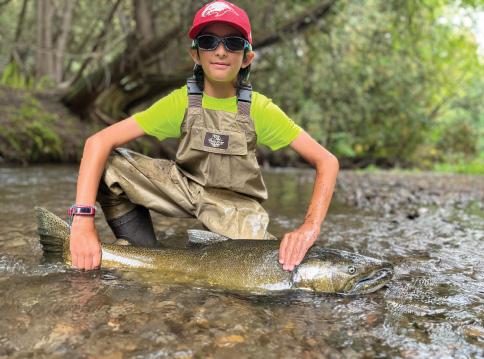
WILDLIFE & WILD PLACES

1ST PLACE
PHOTOGRAPHER: Nancy Carr
WHERE: Fairy Lake, Ontario
WHEN: August 2023
3RD PLACE
PHOTOGRAPHER:
Jonathan Clayton
WHERE: Wilmot Creek, Ontario
WHEN: Late September 2023
DETAILS: A serious amateur photographer who first started taking pictures back when everyone was still using film, Jonathan Clayton took this shot of his son, Asher, posing with the first chinook salmon he ever hooked and fought all by himself. “It was too heavy for him to lift, so I took this photo of him kneeling,” Jonathan says. “Needless to say, he was all smiles on the way home.”
PRIZE: $250 BERKLEY FISHING
TACKLE PRIZE PACK
DETAILS: A recent but enthusiastic convert to wildlife photography, Nancy Carr was out on the water early one morning last August with a friend, hoping to see a bald eagle. They spotted this one tearing into its prey, which they were amazed to discover was a raccoon as they got closer. “We realized it was likely a-once-in-a-lifetime sighting,” Nancy says. “Nothing like being in the right place at the right time.”
PRIZE: VSSL JAVA PORTABLE HAND COFFEE GRINDER
64 OUTDOOR CANADA WINTER 2012 WWW.OUTDOORCANADA.CA
64 | OUTDOOR CANADA [ JULY/AUGUST 2024 ]
SPONSORED BY
PHOTOS DEPICTING WILDLIFE OR NATURAL LANDSCAPES IN CANADA

2ND PLACE
PHOTOGRAPHER: Lainey Daudelin
WHERE: Tumbler Ridge, B.C.
WHEN: April 2023
DETAILS: Lainey Daudelin was out for a short day hike when she spotted a herd of goats and one of the animals happened to turn right toward her camera. A Red Seal heavy-duty mechanic by day at a coal mine, Lainey avidly hunts whitetails, mule deer, moose and pronghorn antelope. She is also a serious amateur photographer, with aspirations to one day become a professional. This stunning shot is a good start.
PRIZE: VSSL CAMP SUPPLIES
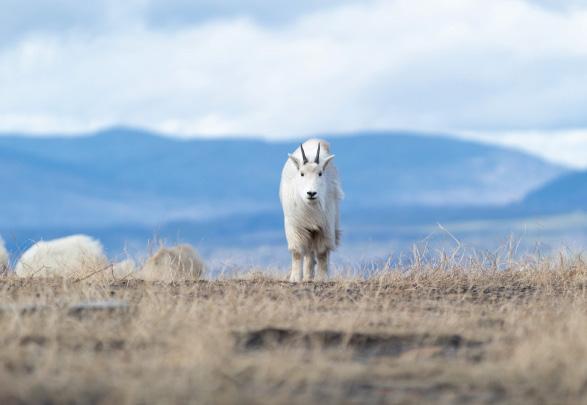

3RD PLACE
PHOTOGRAPHER: Joshua Spencer
WHERE: Delta, B.C.
WHEN: May 2023
DETAILS: Grade 11 student Joshua Spencer has been taking photos for the last three years using an inherited camera. While visiting his grandfather’s farm, where deer, coyotes and the occasional cougar or bear are sighted, the young hunter followed a couple of deer through an old blueberry field. When one peeked back at him, Joshua caught this moment just before it scampered away.
PRIZE: VSSL MINI STASH SPEAKER OC
WWW.OUTDOORCANADA.CA | 65
2ND 3RD 1ST
HOMAGE
BY MIKE FITZGERALD
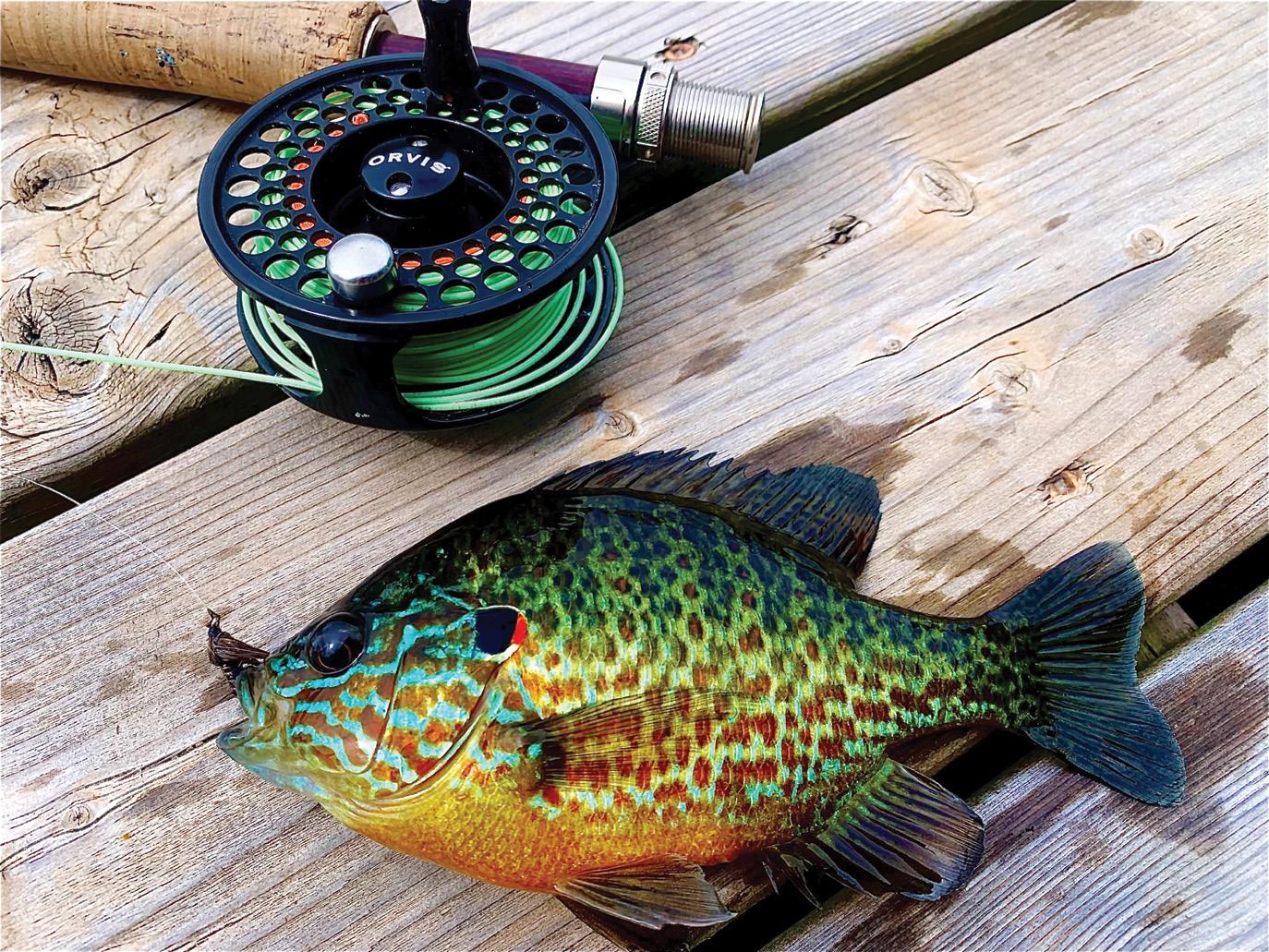
Pumpkinseeds
FOR NOVICE AND EXPERT ANGLERS ALIKE, THEY’RE ALWAYS WILLING TO PLAY ALONG
I’VE NEVER UNDERSTOOD why more anglers don’t spend more time pursuing pumpkinseeds. After all, they’re the only fish native to Canadian waters with an exotic appearance worthy of the finest aquariums. Better yet, they possess every quality necessary to be deemed worthy of year-round angling along much of the country’s southern stretches.
Those who think there’s no challenge in catching pumpkinseeds have never targeted them in the dead of winter—it can be a serious struggle. And anyone who’s kept a few meatier specimens for the skillet knows there’s another tasty world beyond the realm of perch and walleye fillets.
My favourite thing about these feisty members of the sunfish family is they’re accessible to all anglers, young and old, no matter their skill level. All you need is a slip float, some splitshot and a hook to dip a worm below the surface near a dock. Or, you can take things up a notch
and target them with flies or poppers on light tackle. Whatever the case, pumpkinseeds are sure to bring an ear-to-ear smile to a new angler’s face, providing the gateway to a lifetime of angling wonder in the process.
Even if you ignore them now, you’re bound to have loved pumpkinseeds at one point or another in your angling career. No matter how many hooks they swallowed, worms they stole, or times they poked your hand with their spiny dorsal fins, they were always willing to ensure you didn’t go home skunked. And the good news is, it’s never too late to once again cash in on an afternoon of chasing Lepomis gibbosus. From April straight through to the end of October, the fishing can be equated to the likes of pizza—when it’s good, it’s great, but when it’s bad, it’s still pretty good. OC
MIKE FITZGERALD ENJOYS TACKLING PUMPKINSEEDS NEAR HIS HOME IN ONTARIO’S PRINCE EDWARD COUNTY.
WWW.OUTDOORCANADA.CA MIKE FITZGERALD 66 | OUTDOOR CANADA [ JULY/AUGUST 2024 ]
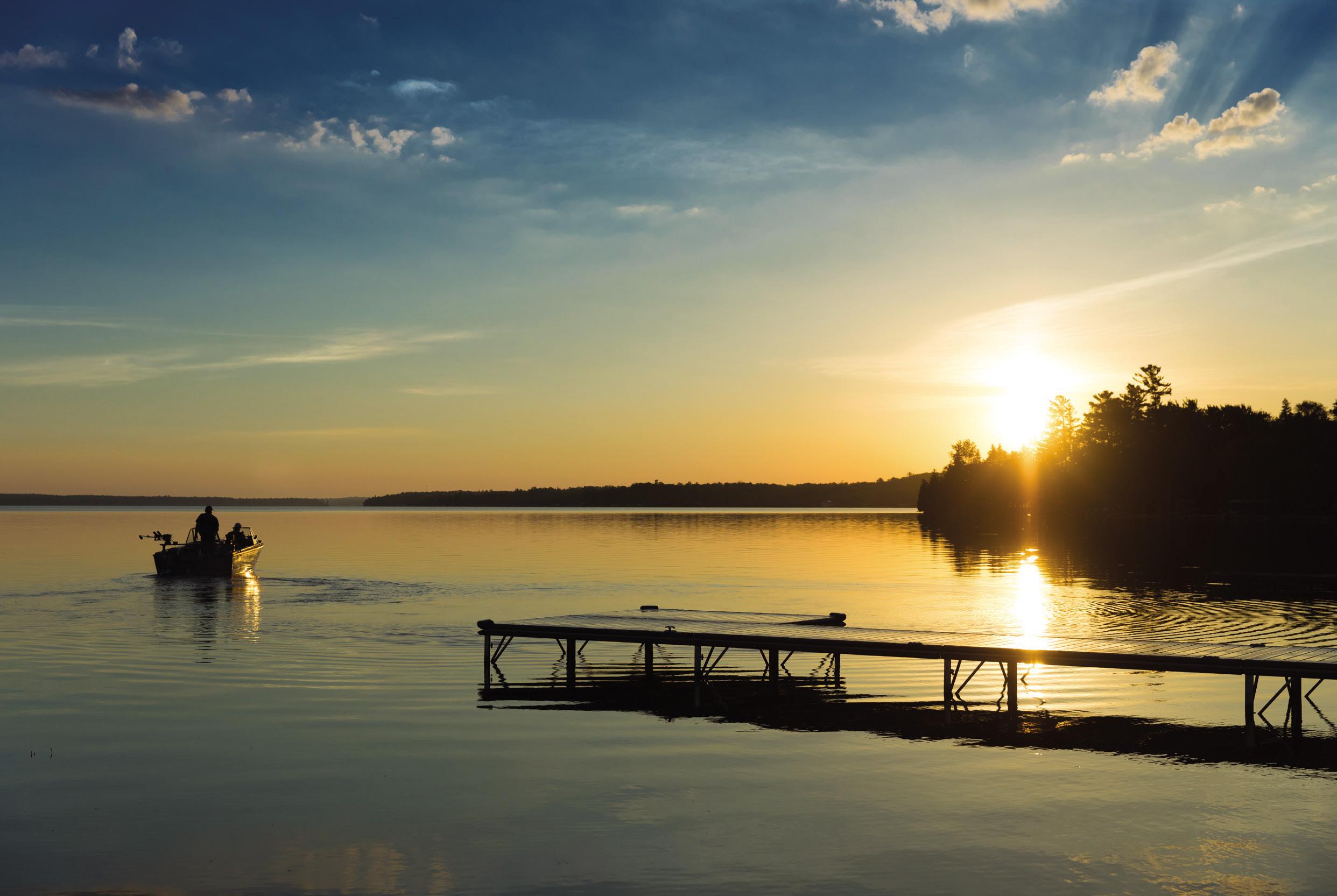



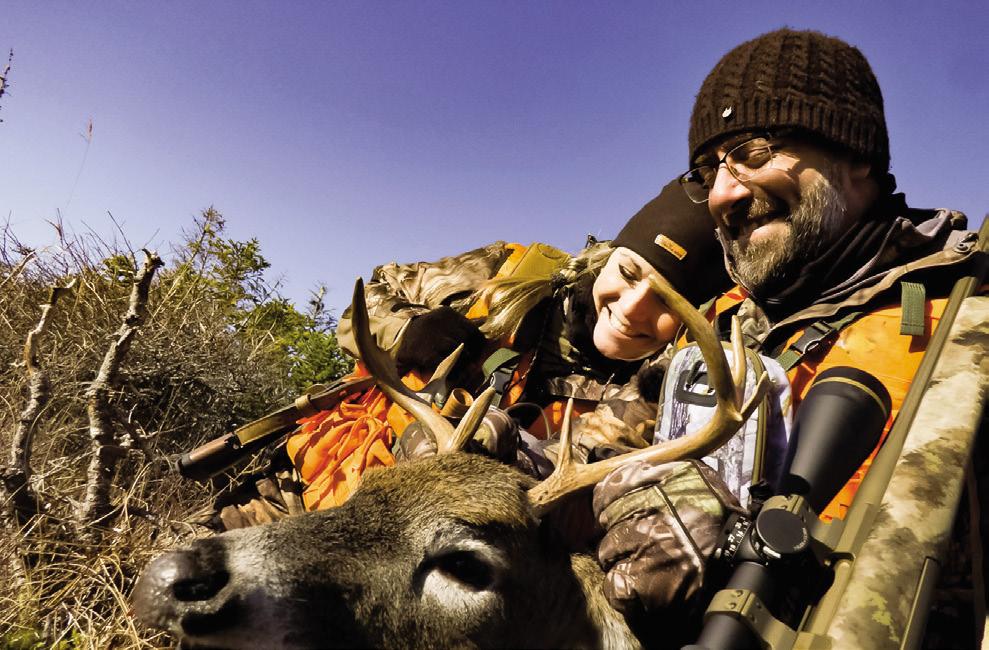
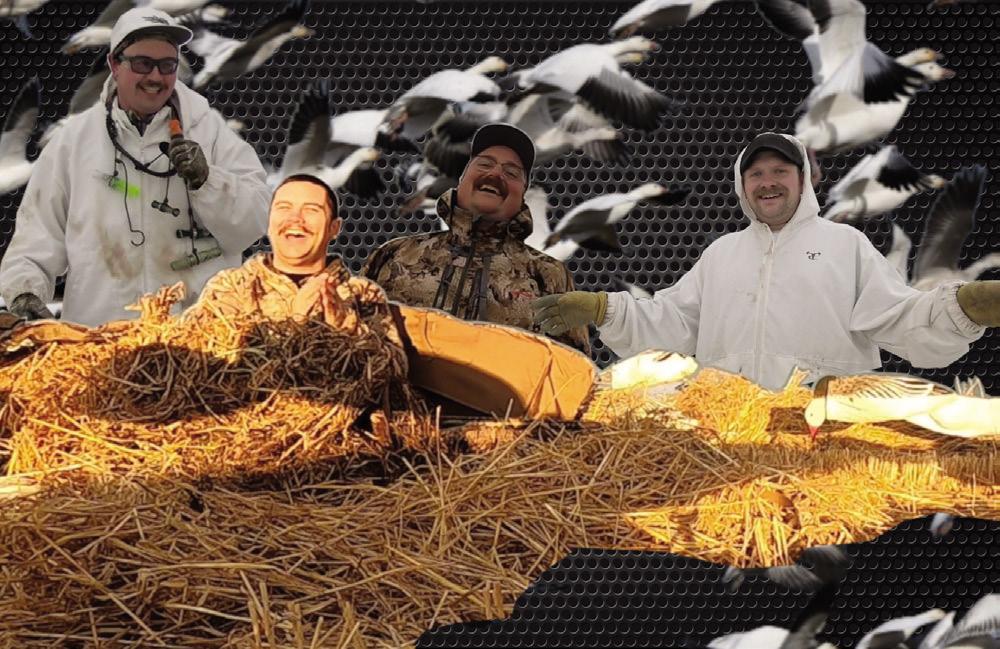


SPORTSMANCANADA.CA
CANADA
FEATURING CANADA’S MOST TRUSTED AND KNOWLEDGEABLE PROGRAMS


Incredible out-of-the-box accuracy, smooth operation and uncompromising reliability with Sako standards. WWW.TIKKACANADA.CA THE ULTIMATE
FOR ACCURACY @TIKKACANADA
TOOL
| Fabbrica
Pietro | Beretta S.P.A Via Pietro Beretta 18 | 25063 Gardone V.T., Italy | www.sakoitalia.it
DISTRIBUTOR
Darmi




























































 BY MARK RAYCROFT
BY MARK RAYCROFT














































































 BY GORD PYZER
BY GORD PYZER










































































































































































